
Want to create or adapt books like this? Learn more about how Pressbooks supports open publishing practices.

2.2 Writing the HRM Plan
Learning objective.
- Describe the steps in the development of an HRM plan.
As addressed in Section 2.1 “Strategic Planning” , the writing of an HRM strategic plan should be based on the strategic plans of the organization and of the department. Once the strategic plan is written, the HR professional can begin work on the HR plan. This is different from the strategic plan in that it is more detailed and more focused on the short term. The six parts described here are addressed in more detail in Chapter 4 “Recruitment” , Chapter 5 “Selection” , Chapter 6 “Compensation and Benefits” , Chapter 7 “Retention and Motivation” , Chapter 8 “Training and Development” , Chapter 9 “Successful Employee Communication” , Chapter 10 “Managing Employee Performance” , and Chapter 11 “Employee Assessment” .
How Would You Handle This?
Compensation Is a Touchy Subject
As the HR manager, you have access to sensitive data, such as pay information. As you are looking at pay for each employee in the marketing department, you notice that two employees with the same job title and performing the same job are earning different amounts of money. As you dig deeper, you notice the employee who has been with the company for the least amount of time is actually getting paid more than the person with longer tenure. A brief look at the performance evaluations shows they are both star performers. You determine that two different managers hired the employees, and one manager is no longer with the organization. How would you handle this?
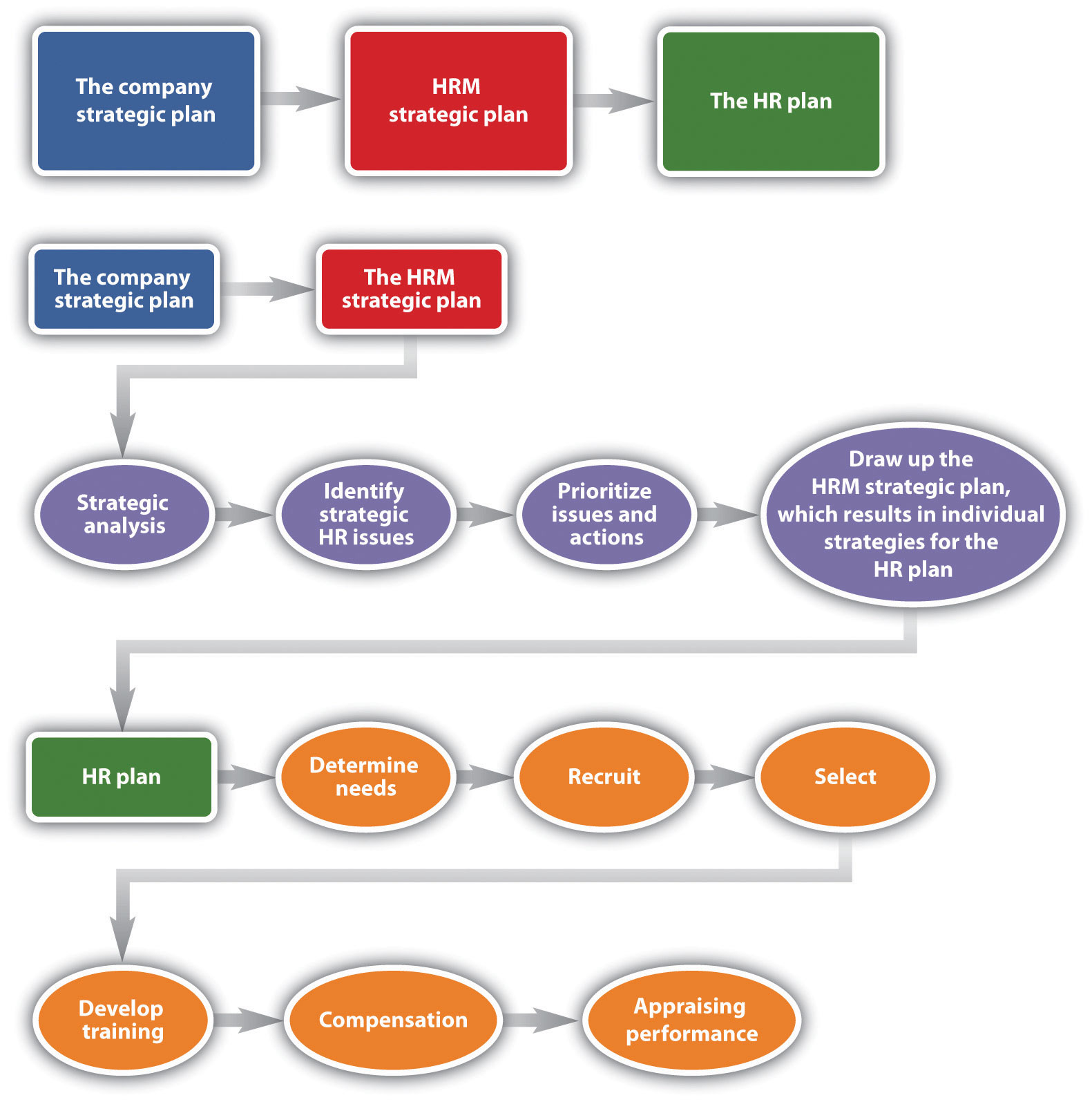
As you can see from this figure, the company strategic plan ties into the HRM strategic plan, and from the HRM strategic plan, the HR plan can be developed.
The six parts of the HRM plan include the following:
- Determine human resource needs. This part is heavily involved with the strategic plan. What growth or decline is expected in the organization? How will this impact your workforce? What is the economic situation? What are your forecasted sales for next year?
- Determine recruiting strategy. Once you have a plan in place, it’s necessary to write down a strategy addressing how you will recruit the right people at the right time.
- Select employees. The selection process consists of the interviewing and hiring process.
- Develop training. Based on the strategic plan, what training needs are arising? Is there new software that everyone must learn? Are there problems in handling conflict? Whatever the training topics are, the HR manager should address plans to offer training in the HRM plan.
- Determine compensation. In this aspect of the HRM plan, the manager must determine pay scales and other compensation such as health care, bonuses, and other perks.
- Appraise performance. Sets of standards need to be developed so you know how to rate the performance of your employees and continue with their development.
Each chapter of this text addresses one area of the HR plan, but the next sections provide some basic knowledge of planning for each area.
Determine Human Resource Needs
The first part of an HR plan will consist of determining how many people are needed. This step involves looking at company operations over the last year and asking a lot of questions:
- Were enough people hired?
- Did you have to scramble to hire people at the last minute?
- What are the skills your current employees possess?
- What skills do your employees need to gain to keep up with technology?
- Who is retiring soon? Do you have someone to replace them?
- What are the sales forecasts? How might this affect your hiring?
These are the questions to answer in this first step of the HR plan process. As you can imagine, this cannot be done alone. Involvement of other departments, managers, and executives should take place to obtain an accurate estimate of staffing needs for now and in the future. We discuss staffing in greater detail in Chapter 4 “Recruitment” .
Many HR managers will prepare an inventory of all current employees, which includes their educational level and abilities. This gives the HR manager the big picture on what current employees can do. It can serve as a tool to develop employees’ skills and abilities, if you know where they are currently in their development. For example, by taking an inventory, you may find out that Richard is going to retire next year, but no one in his department has been identified or trained to take over his role. Keeping the inventory helps you know where gaps might exist and allows you to plan for these gaps. This topic is addressed further in Chapter 4 “Recruitment” .
HR managers will also look closely at all job components and will analyze each job. By doing this analysis, they can get a better picture of what kinds of skills are needed to perform a job successfully. Once the HR manager has performed the needs assessment and knows exactly how many people, and in what positions and time frame they need to be hired, he or she can get to work on recruiting, which is also called a staffing plan . This is addressed further in Chapter 4 “Recruitment” .
Recruitment is an important job of the HR manager. More detail is provided in Chapter 4 “Recruitment” . Knowing how many people to hire, what skills they should possess, and hiring them when the time is right are major challenges in the area of recruiting. Hiring individuals who have not only the skills to do the job but also the attitude, personality, and fit can be the biggest challenge in recruiting. Depending on the type of job you are hiring for, you might place traditional advertisements on the web or use social networking sites as an avenue. Some companies offer bonuses to employees who refer friends. No matter where you decide to recruit, it is important to keep in mind that the recruiting process should be fair and equitable and diversity should be considered. We discuss diversity in greater detail in Chapter 3 “Diversity and Multiculturalism” .
Depending on availability and time, some companies may choose to outsource their recruiting processes. For some types of high-level positions, a head hunter will be used to recruit people nationally and internationally. A head hunter is a person who specializes in matching jobs with people, and they usually work only with high-level positions. Another option is to use an agency that specializes in hiring people for a variety of positions, including temporary and permanent positions. Some companies decide to hire temporary employees because they anticipate only a short-term need, and it can be less expensive to hire someone for only a specified period of time.
No matter how it is done, recruitment is the process of obtaining résumés of people interested in the job. In our next step, we review those résumés, interview, and select the best person for the job.
After you have reviewed résumés for a position, now is the time to work toward selecting the right person for the job. Although we discuss selection in great detail in Chapter 6 “Compensation and Benefits” , it is worth a discussion here as well. Numerous studies have been done, and while they have various results, the majority of studies say it costs an average of $45,000 to hire a new manager (Herman, 1993). While this may seem exaggerated, consider the following items that contribute to the cost:
- Time to review résumés
- Time to interview candidates
- Interview expenses for candidates
- Possible travel expenses for new hire or recruiter
- Possible relocation expenses for new hire
- Additional bookkeeping, payroll, 401(k), and so forth
- Additional record keeping for government agencies
- Increased unemployment insurance costs
- Costs related to lack of productivity while new employee gets up to speed
Because it is so expensive to hire, it is important to do it right. First, résumés are reviewed and people who closely match the right skills are selected for interviews. Many organizations perform phone interviews first so they can further narrow the field. The HR manager is generally responsible for setting up the interviews and determining the interview schedule for a particular candidate. Usually, the more senior the position is, the longer the interview process takes, even up to eight weeks (Crant, 2009). After the interviews are conducted, there may be reference checks, background checks, or testing that will need to be performed before an offer is made to the new employee. HR managers are generally responsible for this aspect. Once the applicant has met all criteria, the HR manager will offer the selected person the position. At this point, salary, benefits, and vacation time may be negotiated. Compensation is the next step in HR management.
Determine Compensation
What you decide to pay people is much more difficult than it seems. This issue is covered in greater detail in Chapter 6 “Compensation and Benefits” . Pay systems must be developed that motivate employees and embody fairness to everyone working at the organization. However, organizations cannot offer every benefit and perk because budgets always have constraints. Even governmental agencies need to be concerned with compensation as part of their HR plan. For example, in 2011, Illinois State University gave salary increases of 3 percent to all faculty, despite state budget cuts in other areas. They reasoned that the pay increase was needed because of the competitive nature of hiring and retaining faculty and staff. The university president said, “Our employees have had a very good year and hopefully this is a good shot in the arm that will keep our morale high” (Pawlowski, 2011).

Determination of compensation systems is a balancing act. Compensation should be high enough to motivate current employees and attract new ones but not so high that it breaks the budget.
Nathan Rupert – Venice Beach Tightrope Walker – CC BY-NC-ND 2.0.
The process in determining the right pay for the right job can have many variables, in addition to keeping morale high. First, as we have already discussed, the organization life cycle can determine the pay strategy for the organization. The supply and demand of those skills in the market, economy, region, or area in which the business is located is a determining factor in compensation strategy. For example, a company operating in Seattle may pay higher for the same job than their division in Missoula, Montana, because the cost of living is higher in Seattle. The HR manager is always researching to ensure the pay is fair and at market value. In Chapter 6 “Compensation and Benefits” , we get into greater detail about the variety of pay systems, perks, and bonuses that can be offered. For many organizations, training is a perk. Employees can develop their skills while getting paid for it. Training is the next step in the HR planning process.
Develop Training
Once we have planned our staffing, recruited people, selected employees, and then compensated them, we want to make sure our new employees are successful. Training is covered in more detail in Chapter 8. One way we can ensure success is by training our employees in three main areas:
- Company culture. A company culture is the organization’s way of doing things. Every company does things a bit differently, and by understanding the corporate culture, the employee will be set up for success. Usually this type of training is performed at an orientation, when an employee is first hired. Topics might include how to request time off, dress codes, and processes.
- Skills needed for the job. If you work for a retail store, your employees need to know how to use the register. If you have sales staff, they need to have product knowledge to do the job. If your company uses particular software, training is needed in this area.
- Human relations skills. These are non-job-specific skills your employees need not only to do their jobs but also to make them all-around successful employees. Skills needed include communication skills and interviewing potential employees.
Perform a Performance Appraisal
The last thing an HR manager should plan is the performance appraisal. While we discuss performance appraisals in greater detail in Chapter 11 “Employee Assessment” , it is definitely worth a mention here, since it is part of the strategic plan. A performance appraisal is a method by which job performance is measured. The performance appraisal can be called many different things, such as the following:
- Employee appraisal
- Performance review
- Career development review
No matter what the name, these appraisals can be very beneficial in motivating and rewarding employees. The performance evaluation includes metrics on which the employee is measured. These metrics should be based on the job description, both of which the HR manager develops. Various types of rating systems can be used, and it’s usually up to the HR manager to develop these as well as employee evaluation forms. The HR manager also usually ensures that every manager in the organization is trained on how to fill out the evaluation forms, but more importantly, how to discuss job performance with the employee. Then the HR manager tracks the due dates of performance appraisals and sends out e-mails to those managers letting them know it is almost time to write an evaluation.
Human Resource Recall
Have you ever been given a performance evaluation? What was the process and the outcome?
Communication Is Key in Performance Evaluations
(click to see video)
Communication is imperative in any workplace, but especially when giving and receiving a performance evaluation.
Key Takeaways
- Human resource planning is a process that is part of the strategic plan. It involves addressing specific needs within the organization, based on the company’s strategic direction.
- The first step in HR planning is determining current and future human resource needs. In this step, current employees, available employees in the market, and future needs are all analyzed and developed.
- In the second step of the process, once we know how many people we will need to hire, we can begin to determine the best methods for recruiting the people we need. Sometimes an organization will use head hunters to find the best person for the job.
- After the recruiting process is finished, the HR manager will begin the selection process. This involves setting up interviews and selecting the right person for the job. This can be an expensive process, so we always want to hire the right person from the beginning.
- HR managers also need to work through compensation plans, including salary, bonus, and other benefits, such as health care. This aspect is important, since most organizations want to use compensation to attract and retain the best employees.
- The HR manager also develops training programs to ensure the people hired have the tools to be able to do their jobs successfully.
- Of the parts of HR planning, which do you think is most difficult, and why? Which would you enjoy the most, and why?
- Why is it important to plan your staffing before you start to hire people?
- What is the significance of training? Why do we need it in organizations?
Crant, J., “How Long Does an Interview Process Take?” Jobsinminneapolis.com, December 2, 2009, accessed October 28, 2010, http://www.jobsinminneapolis.com/articles/title/How-Long-Does-an-Interview-Process-Take/3500/422 .
Herman, S., Hiring Right: A Practical Guide (Thousand Oaks, CA: Sage, 1993), xv.
Pawlowski, S., “Illinois State University to Get Salary Bump,” WJBC Radio, July 11, 2011, accessed July 11, 2011, http://wjbc.com/illinois-state-university-faculty-to-get-salary-bump .
Human Resource Management Copyright © 2016 by University of Minnesota is licensed under a Creative Commons Attribution-NonCommercial-ShareAlike 4.0 International License , except where otherwise noted.
Faculty Resources
Assignments.

The Human Resources Management course includes a series of openly licensed written assignments and discussions aligned to specific learning outcomes and chapters. If you import this course into your learning management system (Blackboard, Canvas, etc.), all of the assignments and discussions (listed in the table, below,) will automatically be loaded into your LMS assignment and discussion-board tools. They can be used as is, modified, combined with your own assignments, or removed altogether.
The assignments in this course align with the following scenario:
You are a college senior who has been selected to participate in a hybrid internship/onboarding program with an elite HR research and advisory firm. Your training consists of a combination of formal education—specifically, enrollment in this Human Resource Management course—and a rotation in support of the principals of the firm. In your rotations, you will synthesize what you’ve learned in the relevant modules to address firm or client issues, conducting additional research as necessary and developing draft deliverables as instructed by the principal consultant. The quality of your deliverables – that is, your ability to convert learning into practical insight – will largely determine whether, at the end of the internship period, you are offered a position with the firm or simply thanked for your participation.
You can view them below or throughout the course.
Rubric for Assignments
There is also a sample rubric to assist you in grading. Instructors may modify these guidelines or use their own.
Discussions
The following discussion assignments will also be preloaded (into the discussion-board tool) in your learning management system if you import the course. They can be used as is, modified, or removed. You can view them below or throughout the course.
Rubric for Discussion Posts
Answer keys for the discussion posts are available to faculty who adopt Waymaker, OHM, or Candela courses with paid support from Lumen Learning. This approach helps us protect the academic integrity of these materials by ensuring they are shared only with authorized and institution-affiliated faculty and staff.
Contribute!
Improve this page Learn More
- Assignments. Provided by : Lumen Learning. License : CC BY: Attribution
- Pencil Cup. Authored by : IconfactoryTeam. Provided by : Noun Project. Located at : https://thenounproject.com/term/pencil-cup/628840/ . License : CC BY: Attribution

Academia.edu no longer supports Internet Explorer.
To browse Academia.edu and the wider internet faster and more securely, please take a few seconds to upgrade your browser .
Enter the email address you signed up with and we'll email you a reset link.
- We're Hiring!
- Help Center

MODULE 1: HUMAN RESOURCE PLANNING

- We're Hiring!
- Help Center
- Find new research papers in:
- Health Sciences
- Earth Sciences
- Cognitive Science
- Mathematics
- Computer Science
- Academia ©2024
- Search Search Please fill out this field.
- Human Resource Planning (HRP)
- Understanding HRP
What Is the Goal of Human Resource Planning (HRP)?
- Human Resource Planning FAQs
The Bottom Line
- Business Essentials
Human Resource Planning (HRP) Meaning, Process, and Examples
Adam Hayes, Ph.D., CFA, is a financial writer with 15+ years Wall Street experience as a derivatives trader. Besides his extensive derivative trading expertise, Adam is an expert in economics and behavioral finance. Adam received his master's in economics from The New School for Social Research and his Ph.D. from the University of Wisconsin-Madison in sociology. He is a CFA charterholder as well as holding FINRA Series 7, 55 & 63 licenses. He currently researches and teaches economic sociology and the social studies of finance at the Hebrew University in Jerusalem.
:max_bytes(150000):strip_icc():format(webp)/adam_hayes-5bfc262a46e0fb005118b414.jpg)
What Is Human Resource Planning (HRP)?
Human resource planning (HRP) is the continuous process of systematic planning to achieve optimum use of an organization's most valuable asset—quality employees. Human resources planning ensures the best fit between employees and jobs while avoiding manpower shortages or surpluses.
There are four key steps to the HRP process. They include analyzing present labor supply, forecasting labor demand, balancing projected labor demand with supply, and supporting organizational goals. HRP is an important investment for any business as it allows companies to remain both productive and profitable.
Key Takeaways
- Human resource planning (HRP) is a strategy used by a company to maintain a steady stream of skilled employees while avoiding employee shortages or surpluses.
- Having a good HRP strategy in place can mean productivity and profitability for a company.
- There are four general steps in the HRP process: identifying the current supply of employees, determining the future of the workforce, balancing between labor supply and demand, and developing plans that support the company's goals.
Michela Buttignol
What Is Human Resource Planning (HRP) Used For?
Human resource planning allows companies to plan ahead so they can maintain a steady supply of skilled employees. The process is used to help companies evaluate their needs and to plan ahead to meet those needs.
Human resource planning needs to be flexible enough to meet short-term staffing challenges while adapting to changing conditions in the business environment over the longer term. HRP starts by assessing and auditing the current capacity of human resources.
Here, identifying a company's skill set and targeting the skills a company needs enables it to strategically reach business goals and be equipped for future challenges. To remain competitive, businesses may need advanced skills or to upskill their employees as the market environment evolves and changes.
To retain employees and remain competitive, HRP often looks at organizational design, employee motivation, succession planning, and increasing return on investment overall.
Challenges of Human Resource Planning (HRP)
The challenges to HRP include forces that are always changing. These include employees getting sick, getting promoted, going on vacation, or leaving for another job. HRP ensures there is the best fit between workers and jobs, avoiding shortages and surpluses in the employee pool.
To help prevent future roadblocks and satisfy their objectives, HR managers have to make plans to do the following:
- Find and attract skilled employees.
- Select, train, and reward the best candidates.
- Cope with absences and deal with conflicts.
- Promote employees or let some of them go.
Investing in HRP is one of the most important decisions a company can make. After all, a company is only as good as its employees, and a high level of employee engagement can be essential for a company's success. If a company has the best employees and the best practices in place, it can mean the difference between sluggishness and productivity, helping to lead a company to profitability.
What Are the Four Steps to Human Resource Planning (HRP)?
There are four general, broad steps involved in the human resource planning process. Each step needs to be taken in sequence in order to arrive at the end goal, which is to develop a strategy that enables the company to successfully find and retain enough qualified employees to meet the company's needs.
Analyzing labor supply
The first step of human resource planning is to identify the company's current human resources supply. In this step, the HR department studies the strength of the organization based on the number of employees, their skills, qualifications, positions, benefits, and performance levels.
Forecasting labor demand
The second step requires the company to outline the future of its workforce. Here, the HR department can consider certain issues like promotions, retirements, layoffs, and transfers—anything that factors into the future needs of a company. The HR department can also look at external conditions impacting labor demand , such as new technology that might increase or decrease the need for workers.
Balancing labor demand with supply
The third step in the HRP process is forecasting the employment demand. HR creates a gap analysis that lays out specific needs to narrow the supply of the company's labor versus future demand. This analysis will often generate a series of questions, such as:
- Should employees learn new skills?
- Does the company need more managers?
- Do all employees play to their strengths in their current roles?
Developing and implementing a plan
The answers to questions from the gap analysis help HR determine how to proceed, which is the final phase of the HRP process. HR must now take practical steps to integrate its plan with the rest of the company. The department needs a budget , the ability to implement the plan, and a collaborative effort with all departments to execute that plan.
Common HR policies put in place after this fourth step may include policies regarding vacation, holidays, sick days, overtime compensation, and termination.
The goal of HR planning is to have the optimal number of staff to make the most money for the company. Because the goals and strategies of a company change over time, human resource planning must adapt accordingly. Additionally, as globalization increases, HR departments will face the need to implement new practices to accommodate government labor regulations that vary from country to country.
The increased use of remote workers by many corporations will also impact human resource planning and will require HR departments to use new methods and tools to recruit, train, and retain workers.
Why Is Human Resource Planning Important?
Human resource planning (HRP) allows a business to better maintain and target the right kind of talent to employ—having the right technical and soft skills to optimize their function within the company. It also allows managers to better train the workforce and help them develop the required skills.
What Is "Hard" vs. "Soft" Human Resource Planning?
Hard HRP evaluates various quantitative metrics to ensure that the right number of the right sort of people are available when needed by the company. Soft HRP focuses more on finding employees with the right corporate culture, motivation, and attitude. Often these are used in tandem.
What Are the Basic Steps in HRP?
HRP begins with an analysis of the available labor pool from which a company can draw. It then evaluates the firm's present and future demand for various types of labor and attempts to match that demand with the supply of job applicants.
Quality employees are a company's most valuable asset. Human resource planning involves the development of strategies to ensure that a business has an adequate supply of employees to meet its needs and can avoid either a surplus or a lack of workers.
There are four general steps in developing such a strategy: first, analyzing the company's current labor supply; second, determining the company's future labor needs; third, balancing the company's labor needs with its supply of employees; and fourth, developing and implementing the HR plan throughout the organization.
A solid HRP strategy can help a company be both productive and profitable.
International Journal of Business and Management Invention. " Human Resource Planning-An Analytical Study ," Page 64.
:max_bytes(150000):strip_icc():format(webp)/operational_risk.asp-Final-4be32b4ee5c74958b22dfddd7262966f.png)
- Terms of Service
- Editorial Policy
- Privacy Policy
- Your Privacy Choices
Human Resource Planning Guide and Templates Every HR Team Needs
Posted 21 October, 2021 in Human Resources , Strategy

Businesses will demand more and more of Human Resources teams this year. It’s a big challenge – and opportunity – for HR Managers.
The face of the workplace has changed. Today's new normal is a hybrid workforce, operating a mixture of centralized and remote work. But more change is still to come.
Strategic priorities such as change management require dedicated focus, but key areas like employee engagement can’t be neglected. Managing the needs of the business as well as those of staff will call for careful balancing.
To juggle these conflicting demands, HR managers need a plan. Effective Human Resource planning charts the course for the year ahead. It makes it easier for organizations to recruit, retain and reinforce the strong workforce needed to achieve business goals.
In this article, we summarize the top things Human Resource Managers should focus on this year, outline the steps to creating an effective HR Plan, and share planning templates that are free for you to download.
Jump ahead:
The key HR priorities this year
How to create an effective hr plan, download human resource plan templates, 1. development and training.
The biggest priority for HR Managers, according to Gartner , is building critical skills and competencies. This is how successful organizations maximize workplace performance and maintain competitive advantage.
It’s an area where digital can really drive HR . Skills gaps and training needs can be readily identified, and customized development programs delivered – avoiding those stuffy meeting rooms and ‘one size fits all’ training.
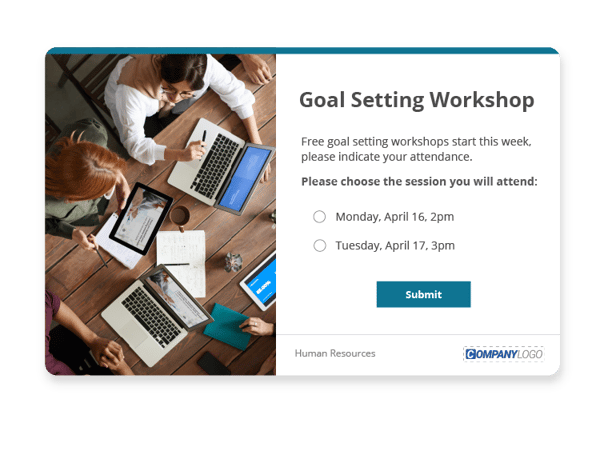
2. Employee engagement
Engagement relies on connecting with employees. That’s why so many organizations have seen drops in engagement during times of remote work .
Staff isolated by geography experience disconnection with the company. The absence of regular in-person contact causes employees to feel more removed from their team, their managers, and the company.
Recent HR research proves using multiple communication channels to be more effective in engaging different groups of staff.
3. Change communications
Gartner reports that organizational design and change management is the second-highest priority for HR Managers. This has the potential to further destabilize already uncertain employees. Managing and communicating this is critical.
Managers and HR teams are flooded with questions from employees on the nature of these changes and how their role is affected. Strong, visible leadership is essential to maintain morale, ensure business continuity and protect the brand.
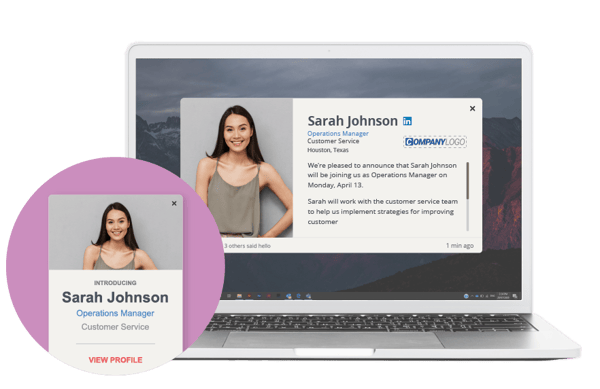
4. Recruiting and onboarding
Recruitment hasn’t ceased just because we’re working remotely. Far from it. But effective onboarding is more critical than ever.
With in-person onboarding, new hires would be welcomed to the organization with a tour of the facilities, introductions with key personnel, and shared social occasions, all designed to integrate them and make them feel comfortable.
Today’s online onboarding must replicate the benefits of in-person onboarding, but leverage the opportunities of the digital environment to create a richer, more immersive experience.
5. Health and wellbeing
Work is stressful, even under normal conditions. That’s why one million workers in the United States miss work every day due to stress. But combine this with the demands of remote working and restrictions of social isolation, and the impact on employee wellbeing is amplified.
Employees find themselves spending high amounts of screen time, taking fewer breaks, and neglecting exercise and nutrition. Left unresolved, these can seriously affect both physical wellness and psychological health.

6. Workplace culture
The importance of positive company culture is well understood. Companies with strong cultures saw a 400% increase in revenue growth. But how can strong company culture be fostered digitally?
Shared social and team-building experiences, the traditional foundation of workplace culture, are no longer possible. Without the personal touch of centralized workplaces, relationships require more effort to maintain.
There are three key stages to successfully preparing, creating, and executing your HR strategy: Plan, Implement, Track. Each stage includes information to gather and things to prepare from initial scoping through launching to staff to assessing performance.
While they can seem overwhelming at first, they are important to improve HR communication and ensure your plan achieves its objectives. A summary of these is shown here - and included in the downloadable planning checklist below.
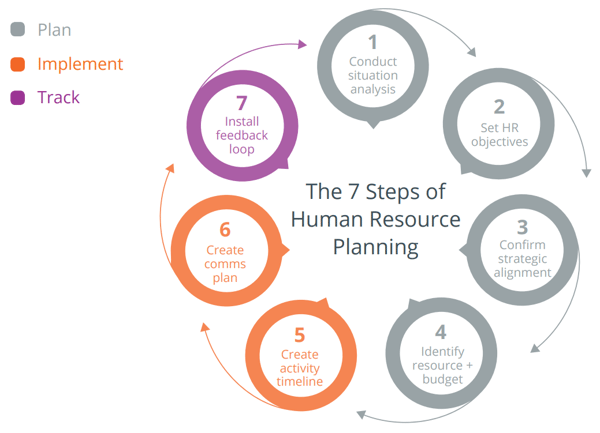
Situation analysis – defining the current state of the business and the desired future state
HR objectives – confirming key Human Resources priorities with SMART goals
Strategic alignment – ensuring HR objectives support overall company goals
Resource requirements – summarizing what is available now and what is required to deliver to HR objectives (this could be people, capabilities, systems, or support)
Budget requirements – establishing funding requirements for additional resources in line with objectives
2. Implement
Timeline of activities – specifying the timeframe for goal achievements and setting major milestones to be met along the way
Communication plan – defining key messages to be delivered, audiences to be targeted and channels to be employed
Content creation – identifying any new process, policies, or training materials required
Plan B – confirming a contingency in the event of poor results or change in circumstances
Feedback mechanisms – introducing a way to track campaign performance, gauge employee sentiment, and identify focus areas for improvement
Regular reporting – setting a schedule to provide performance updates for staff and management
With so much for Human Resources Managers to consider when creating their plans, we've prepared some free downloadable templates to help. Access these through the form below and share them with your HR team. You'll receive:
Strategy guide - Details on the 6 things your plan needs to succeed this year
Planning checklist - Make sure your plan covers everything it needs to (including a plan B)
Activity schedule template - Track all your goals and initiatives in this editable project management tool that works alongside the annual HR calendar
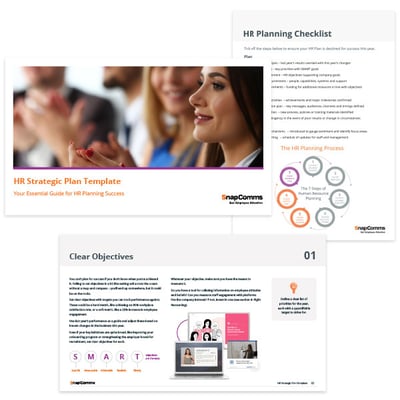
To get your free copy of each of these valuable resources, simply complete this form.
Share This on:
Human Resources Strategy

More blogs by Michael Hartland
Michael Hartland is Content Marketing Manager at SnapComms - the market-leading provider of digital employee engagement solutions. Michael's most happy when writing. The beauty of language and the power of communication are his passions.
Browse by Topic
- Internal Communications (106)
- Human Resources (69)
- Hospitals and Healthcare (25)
- Strategy (17)
- Health and Wellness (16)
- IT and Technology (16)
- Cyber Security (13)
- Leadership (12)
- Culture (11)
- Employee Engagement (10)
- Change Comms (8)
- Compliance and Ethics (8)
- Product Insights (7)
- Financial Services (5)
- Crisis Comms (4)
- Digital Transformation (4)
- Employee Experience (4)
- Conference (3)
- Onboarding (3)
- Contact Center (2)
- Education (2)
Best Practice, Tips and Free Tools
All you need to supercharge your comms - direct to your Inbox

Popular Blogs
Explore more helpful articles.
Human Resources | Strategy
HR Calendar of Activities 2024
Internal Communications | Human Resources
How To Use Digital Signage For Internal Communications
Human Resources | Employee Engagement
What is Employee Engagement? (Defined with Best Practices)
Got any questions? We're here to help.
- SnapComms on Facebook
- SnapComms on LinkedIn
- SnapComms on Youtube
- SnapComms on Twitter
We've updated our EU-US Privacy Shield Privacy Policy Document with updated contact information. View our policy.
Human resource planning (HRP) Exploratory Essay
Today, chief executive officers (CEOs) refer to their workforce (or human capital) as their organizations’ chief asset. This statement underpins the importance of the concept of human resource in organizations.
Human resource planning (HRP) enables an organization to better realize its goals by ensuring that it makes efficient and effective use of its human capital.
Today’s workforce is characteristically ambitious and hence, volatile. Rosenberg (n.d.) reiterates that employees switch careers an approximated three times in their working life. Even with this change in the nature of the workforce employer, employee and customer demands and expectations remain the same.
In addition to these, organizations are competing immensely for high quality talent and are at the same time investing heavily in acquiring and retaining it as these is crucial in meeting business objectives and goals.
Thus, HR managers have an additional task, which is HRP that is instrumental in dealing with the element of uncertainty as it pertains to an employee’s future. From an organization’s point of view a translation of HRP is making good use of an employee while he/she is in the organization’s hands.
Yan et al (2009) reiterates that an organization’s workforce (or human capital) is a valuable asset. A robust human capital is a critical success factor in ensuring that the expectations of customers are met, which is the key to positive financial performance.
Realizing such a robust human capital requires a sound and strategic HR policy, which ensures that an organization recruits the best expertise available and makes the best use of it for as long as it can. Forecasting an organization’s current and future financial needs and HRP are core units of such an HR policy.
HRP is according to Dessler (2001, p. 24) the process of “anticipating future demand for staff, allocating different kinds of staff within organisations, and developing systems for calculating human resource requirements based on accurate records and forecasting techniques”. What HRP does is that it facilitates the effective use of an organization’s human capital.
It does this by ensuring that the right personnel are working at the right place and at the right moment. Forecasting an organization’s current and future HR needs involves using either a quantitative approach or a qualitative one.
The quantitative approach to forecasting an organization HR needs involves numerical quantification of employees by use of statistical and mathematical procedures. By grouping the resultant numerical entities into applicable groups it is possible to determine HR excesses, deficits and inconsistencies.
Examples of applicable groups include age, pay, gender, qualifications and performance rating. HR managers co-work with statistical and mathematical experts to ensure that there is accurate quantitative forecasting.
The qualitative approach to forecasting an organization’s HR needs involves consultations with experts. The opinions of the expert drawn from the consultations enlighten the organization on what its HR needs are, specifically, staffing requirements and career development paths to pursue.
The expert bases his/her opinions on evaluations on employee performance and potential for promotion. A comparison of the quantitative and qualitative forecasting approaches reveals that the latter is more popular as it is cost and time saving.
There are a number of factors that HR managers should consider when undertaking HRP. According to Stone (2008) one these factors is women in the workforce. Today’s workforce contains an increasing number of women. An incentive that is greatly contributing to this increase is the use of mother-friendly alternative working arrangements in organizations.
For instance, employers are providing mothers with flexible work arrangements, special parental leaves, job sharing arrangements, childcare facilities within the organization’s premises, telecommuting work arrangements etc. From 1982 to 2005 Australia has seen a rise of 18.7% in the number of females in employment who are between the ages of 18 and 64 years (Australian Bureau of Statistics, 2010).
In addition to this, from 1989 to 2004 Australia has also seen a rise of 6% in the number of working mothers (Australian Bureau of Statistics, 2010). HR managers when doing HRP should be aware of the fact that the number of women in the workforce is on a rise and should therefore put in place mechanisms that attract and retain them.
To illustrate the above point lets take the example of Diane Gibney. Diane returns to work at her former employer’s veterinary clinic after giving birth to her first child. Due to post antenatal commitments she asks her former employer for an alternative working arrangement, namely, flextime which would allow her to work at given times of the day. The employer refuses to offer her such a working arrangement.
Following the employer’s refusal Diane quits her job and with another partner opens their own veterinary clinic. The 14 staff members in Diane’s new clinic are all female. She is sensitive to antenatal commitments and accords her employees flexible working arrangements so that they are able to attend to them. This example underpins the appreciation that employers should give to mother-friendly HR policies.
Another example is that of Caroline Coops. Caroline’s has a strong commitment and a high motivation to work for her current employer. The reason for this is that the employer accommodates flexible working arrangements that particularly enable and empower mothers to attend to their antenatal commitments. Though Caroline is not a mother yet, this provision by her employer has had a profound effect on her.
It gives her piece of mind knowing that when such commitments arise she is able to adjust a working schedule so that she can better attend to her family needs. This example shows that family-friendly HR policies attract women into employment and are instrumental in retaining them in the organization’s workforce.
Employee retention is critical in meeting business objectives as the direct and indirect costs employers incur to employee turnover are phenomenal. Direct costs are those that an employer incurs when replacing the individual who has made the turn over. Indirect costs are those that the employer incurs because of reduced productivity. Attracting high quality talent to an organization is also critical in meeting business objectives.
Flexible working arrangements that are family-friendly enable organizations to attract and retain such talent as shown from the two examples above. In other words, such working arrangements enable employers to combat employee turnover and at the same time attract high quality talent to the organization.
They are a critical business success factors with today’s workforce that contains an increasing number of women and particularly mothers.
According to Stone (2008) another factor for HR managers to consider when doing HRP is globalization. Dessler (2001) describes globalization simply as the venturing of businesses into new international markets. Advances in information technology have been and continue to be instrumental in globalization. Soon the world will be a global village with ecological and socio-political systems that are dependent on each other.
An advantage of globalization is that employers have a bigger market in which they can shop for individuals with the right levels of skill, experience and knowledge.
An outright disadvantage of globalization is that it supports or encourages brain drain. Organizations that are global employers via globalization should manage their multiracial and culturally diverse workforce in such a way that conflicts between employees are at a minimal.
To illustrate that globalization is a factor that HR managers should consider when undertaking HRP we take the example of an American firm which invested in England. The firm bought a textile machinery company near Birmingham. To boost productivity the American manager of the textile machinery company set about on cutting the time lost on tea breaks, which amounted to thirty minutes in a day per employee.
Culturally, having tea in such a manner is not a big issue to Americans but it is to the English. So, by the direction and instruction of the American manager a tea-maker machine was installed in the company. An infuriated workforce went on a riot demanding the removal of the tea-maker machine. The American manager had to comply with the demands of his English workforce.
According to Stone (2008) another factor that HR managers should consider when undertaking HRP is ageing population. The current situation in most economies of the world is a workforce with, first, less people entering it and second, an ageing and near retirement population. This is an impending crisis for employers. Soon, there will be a lack of both skilled and experienced labour.
At the moment, individuals nearing retirement are the ones fuelling a huge portion of workforce growth. This means that when this ageing population retires workforce growth will almost stagnate causing a huge problem to employers.
Additionally, mature age workers tend to be more loyal and productive in comparison to their younger counterparts. It is therefore imperative that HR managers start figuring out how they can retain their organization’s mature workers.
To illustrate that ageing population is a factor that HR managers should consider when undertaking HRP we consider the case of Peter Jordan. Peter Jordan is a business consultant. He is of the opinion that HR managers should redirect their employee retention efforts towards keeping mature workers (Porter, 2008).
Jordan cites this as being crucial in averting or mitigating the effects of an imminent staff and knowledge shortfall that is about to hit in the very near future (Porter, 2008). Jordan additionally points out that there is more justification for this strategy when you consider employee loyalty between the mature and young age workforce (Porter, 2008).
Jordan opines that there is more employee loyalty in mature age workforce than in the young age workforce (Porter, 2008). Craig Perret feels the same way as Jordan’s pointing out that, HR managers should develop policies that encourage the mature age workforce to remain at work (Porter, 2008).
Other factors on top of these three that HR managers should consider when undertaking HRP are employment, organizational structure and culture, outsourcing and technological changes in society. HR managers should take a keen interest on the rate of employment in their countries.
Organizational structure and culture are instrumental in lifting employee morale and commitment to an organization. Technological changes in society can eliminate the need for certain employees in an organization thus bringing in cost cutting benefits. Outsourcing is a means for increasing capacity in organizations so that customer demand is met.
Australian Bureau of Statistics. (2010b). Women’s income . Web.
Dessler, G. (2001). Human Resource Management (8th ed.). Upper Saddle River, New Jersey: Prentice-Hall Inc.
Porter, L. (2008). Boomers can keep sea change at bay. The Age , p. 23. Web.
Rosenberg McKay, D. (n.d.). How often to people change careers? About.com: Career Planning. Web.
Stone, R. J. (2008). Human Resource Management (6th ed.). Milton, Qld, Australia: Wiley.
Yan, A., Rao, Y., Liao, C. & Gao, C. (2009). Competency identification of sales staff in the agricultural seed industry: Evidence of seed firms in China . Web.
- Chicago (A-D)
- Chicago (N-B)
IvyPanda. (2024, January 16). Human resource planning (HRP). https://ivypanda.com/essays/human-resource-planning-hrp/
"Human resource planning (HRP)." IvyPanda , 16 Jan. 2024, ivypanda.com/essays/human-resource-planning-hrp/.
IvyPanda . (2024) 'Human resource planning (HRP)'. 16 January.
IvyPanda . 2024. "Human resource planning (HRP)." January 16, 2024. https://ivypanda.com/essays/human-resource-planning-hrp/.
1. IvyPanda . "Human resource planning (HRP)." January 16, 2024. https://ivypanda.com/essays/human-resource-planning-hrp/.
Bibliography
IvyPanda . "Human resource planning (HRP)." January 16, 2024. https://ivypanda.com/essays/human-resource-planning-hrp/.
- The Essence of the Human Resource Planning
- External Labour Market Factors
- Successful Strategic Human Resource Planning
- Starbucks HR Issues and Strategies
- Becton Dickinson: Recommendations to Improve HR Functions
- The Diane Kordas Jewellery Website Proposal
- “Negotiating Without a Net” by Diane Coutu
- American School System Overview by Diane Ravitch
- Synesthesia in A Natural History of the Senses by Diane Ackerman
- Photographer Diane Arbus' Creativity Analysis
- Managerial Implications of Employee Engagement
- Spotlight on Strategic Human Resource Management
- Building a Restaurant Concept
- Operations Management at JnJ
- Johnson & Johnson Company Human Resource Management Model
Use Human Resources Planning to Forecast for (Less) Risky Business
By Becky Simon | October 18, 2017 (updated July 21, 2021)
- Share on Facebook
- Share on LinkedIn
Link copied
No organization can afford the risk of a critical skills shortage. Human resource planning (HRP) helps to ensure that you have the right people on your team - those with the skills to compete, innovate, or grow your company.
How do you anticipate workforce needs in a business environment where the rate of change is increasing while the number of people with the right skills is shrinking? The answer is human resource planning. In this article, five experts share their perspectives on what’s needed to operate comfortably in rapidly changing times. While human resources (HR) forecasting isn’t an exact science, you’ll find ideas and processes, examples, and templates that you can use to forecast more confidently, manage operations, and take control to increase current and future profitability.
What Is the Meaning of Human Resource Planning?
Human resource planning, also known as workforce planning , helps organizations recruit, retain, and optimize the deployment of people needed to meet strategic business objectives and to respond to changes in the external environment. In order to proactively avoid talent shortages or surpluses and achieve a balance of talent based on need, effective human resource planning is an ongoing, systematic process.

Darrin Murriner is the author of Corporate Bravery , a field guide to eliminating fear-based decisions, and the Co-founder of Cloverleaf.me , a technology platform that helps business leaders and managers build thriving teams.
He says, “Human resource planning and organizational strategy connect at the hip. You can't deliver business strategy without making sure you have the right human capital you need in the right places for the task at hand.”
Smart companies get the human capital part right by implementing a tactical human resource plan that connects directly to organizational and human resource strategies.
Starbucks: Serving Up Human Resources Planning Derived from Mission and Strategy
Starbucks, the world’s largest coffee chain, recorded $21.3 billion in sales for 2016, ranking it at 131 on the 2017 Fortune 500. The company projects that it will reach $35 billion in sales by 2021 by opening 12,000 stores over the next five years , the majority of them in China. How do you plan human resources with such a massive growth goal? For Starbucks, their approach remains the same no matter where stores are located. Their human resource planning flows from its organizational strategy and its brand. People are Starbucks’ primary resource, as their mission clearly states: "Our mission: to inspire and nurture the human spirit – one person, one cup, and one neighborhood at a time."
An important aspect of Starbucks’ human resource planning is its selection process, which uses specific interview techniques to determine if potential employees are ‘on brand’ and evaluate their skill sets. The company identifies capable company leaders and hires them using a program called "New Partner Orientation and Immersion." This human resources planning approach has led to the lowest employee turnover rate among quick-service restaurants. While most quick-serve restaurants range between 150 to 400 percent turnover, Starbucks’ rate is 65 percent . The company is always on the lookout for new employee perks and focuses energy on employee training, which includes an elaborate online portal that offers an instruction program imparting the necessary job knowledge.
The Difference Between Strategic Human Resources Planning and Human Resources Planning
“The war for talent around the world continues to grow.” says Matthew Burr, Moderator of the Upstate HR Podcast and Principal at Burr Consulting, LLC , a human resource consulting firm focused on small and medium organizations. To win the human capital competition, companies should use a strategic human resource plan as a roadmap to achieve three- to five-year goals. Strategic plans influence the development of tactical resource planning (Starbucks being a prime example). For example, a human resources strategic plan may include long-term aims to recruit and retain an excellent staff with a high-level of technical expertise. The tactical plan would include detailed action plans with completion due dates. For the strategic recruitment goals, the tactical program might consist of short-term goals, such as benchmarking salaries via survey data, or creating a social media campaign to identify and recruit technical professionals. The plan may also target filling IT positions through international recruiting.
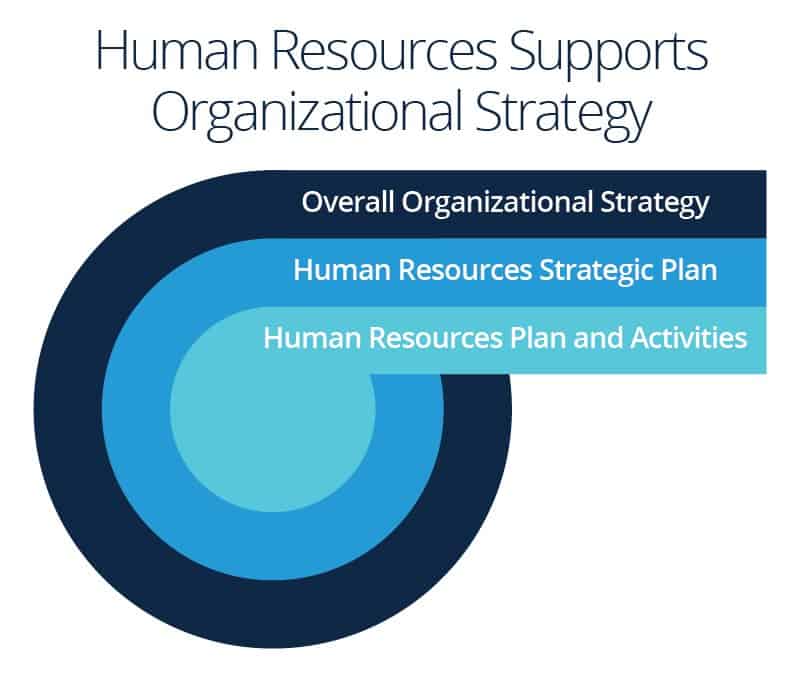
Both strategic and tactical human resource plans support the overall organizational strategy. To learn more about strategic human resources management, read Welcome to the HR Revolution: Strategic Human Resources Management .
Why Is It Important to Plan Human Resources?
Our world is increasingly one of swift technological change, constant product innovation, economic globalization, and generational and cultural shifts. Correspondingly, the life cycles of business designs and products are shortening. Companies must adapt. More than physical or financial capital, human capital efficiently adapts to this new reality. Simultaneously, human capital is at most significant risk of depreciation or obsolescence within a business — and that’s a risk that organizations can’t afford if they’re going to survive and thrive. In fact, only 12% of firms that were on the Fortune 500 list in 1955 remain on the list in 2016.

“Talented people will always have options; Knowing succession plans, training, leadership development will be a tremendous asset to a growing firm,” adds Burr. “HR planning is critical to organizational strategy: We need subject matter experts and leaders to drive the strategy forward in evolving industries. HR planning plays a significant part in supporting strategy, as human resources are the biggest investment for any organization. Evolving laws and regulations also impact strategy internationally. Staffing levels, recruitment and retention programs support scalability of any firm or organization.”

Handrick says it’s all about planning for future growth. “Small businesses that are planning to open a physical or second location also need to think through their HR strategy. Most small businesses begin as sole proprietorships. They need to know when it makes sense to bring on staff, where that staff will work, their compensation, and how to offer benefits, perhaps by partnering with a professional employer organization (PEO).”
- Improving Company Operations: Human capital management and resource planning is a driver for improved company operations and value creation. In July 2017, a group of institutional investors petitioned the Securities and Exchange Commission to disclose policies, practices, and performance of public companies’ human resources management . The petition signifies a move to use workforce analytics to measure the value of an organization’s most valuable asset in a knowledge-based economy .

“You need to work systemically,” says Adler. “Part of the operating plan has to be a workforce plan. HR has to make sure they have a place at the strategy and decision-making table. In my experience, I’ve seen that HR usually doesn’t get involved until it’s late. In this environment, you need to be moving at the speed of light and not the speed of sound.”
- The Talent Shortage and Demographic Change: In its 2016/2017 Talent Shortage Survey , the ManpowerGroup reported the highest worldwide talent shortage since 2007. Forty percent of employers are having difficulty filling positions, up from 38 percent in 2015. The Harvard Business Review article, Employers Aren’t Just Whining - the “Skills Gap” Is Real , states that “New technologies frequently require specific new skills that schools don’t teach and that labor markets don’t supply.” At the same time, there’s a demographic change. In most developed economies, the ‘silver tsunami’ - the group of aging individuals that results from ebbing birth rates and graying baby boomers - is surging. The percentage of the U.S. workforce between the ages of 55 and 64 is growing faster than any other age group.
- Technological Change and The New Generation: Millennials now make up more than 50 percent of the current workforce — and will be 75 percent of the global workforce by 2020 . Human resources need to ride this rising tide and learn to welcome technological advancements to meet talent’s expectations and business requirements. Talent and workplace analytics will become customary, and organizations using the data will be far more competitive.
- Organizational Change: With technology driving change everywhere, organizations need to be nimble and often make significant changes in the way they do business. They also need to make changes with care. Research shows that change initiatives are more likely to fail because of poor communication, employee resistance, and failure to adequately prepare. Human resources are an integral part of change management , which is a systematic approach that applies tools, knowledge, and resources to deal with business transformation. The primary goal of change management is to successfully implement new processes, products, and business strategies while minimizing adverse outcomes. Effective change management includes and also goes beyond project management and involves leading the "people side" of the change equation.
- Government/Legislative Changes: Each state has regulations that affect everything from employee criminal records checks, labor relations, records retention, and mileage reimbursements. Additional federal laws impact human resource management, too. Consequently, human resource professionals need to be conversant in dynamic employment law to minimize company liability. Not being on top of legislation can pose a significant risk to companies and expose them to expensive lawsuits or damage their brand, which can also be off-putting for potential hires.
Seven Steps to Human Resource Planning
There are seven different steps in the human resource planning process, but the pivot point is forecasting demand. That means that today’s human resources professionals need to have a well-rounded picture of their own company and a grasp of multiple factors to put together a plan. “Understanding the three- to five-year business strategy provides what HR must have to forecast workforce needs within the firm,” says Burr. “But there’s also a need to understand the global economy and potential growth options, laws, and regulations to add value to any HR strategy and forecast.”
The seven steps to creating a human resource plan provide a roadmap for companies, but one size does not fit all. The amount of detail and which factors to include are different for every organization. Startup sole proprietorships working in a single geographic area will need to create an entirely different plan than a multinational enterprise.
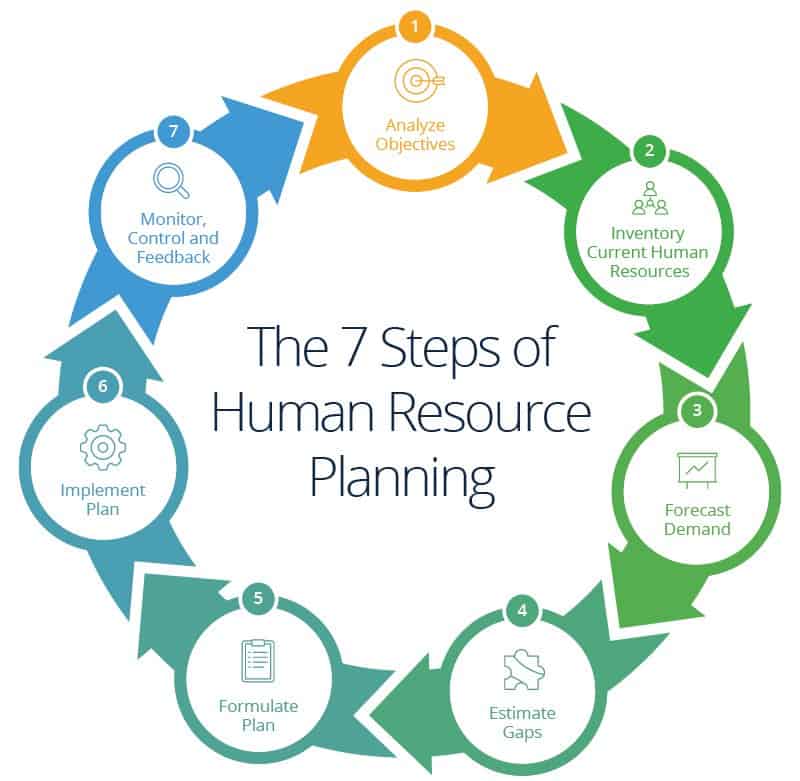
Step One: Analyze Organizational Objectives
Aligning HR practices to strategic objectives is fundamental to an effective human resources plan. In a perfect world, human resources management works hand in hand with other top managers so there is a clear understanding of ultimate goals, and then they focus on the human capital needed to meet them. It’s vital that the human resources plan encompasses every part of the company from product development to sales and expansion plans.
HR Strategic Plan Template
If your company hasn’t written a strategic human resource plan, this template will help you get started. Modify the template to suit your specific needs or to focus on target areas such as benefits or retirement. Stakeholders will appreciate the basic design when they want to review important aspects of your plan.
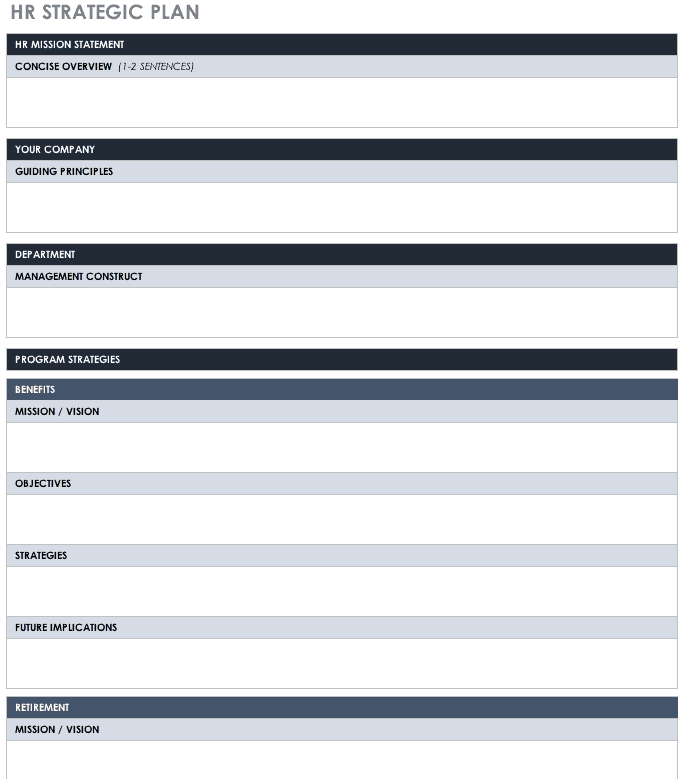
Download HR Strategic Plan Template
Need more strategic planning templates to clarify goals for your organization? You can find more free strategic planning templates here .
Step Two: Inventory Current Human Resources
If you have one, use the updated human resource information storage (HRIS) system to analyze the number of people you currently employ, along with their skills, performance, and potential. Once you determine which jobs need to be filled based on your forecast, you can then decide whether you have enough internal candidates to fill the job requirements or if you need to go to external sources or strategies to add staff.
Employee Evaluation Template
If you don’t have an HRIS system, you can use this performance evaluation template for performance reviews and as a first step in referencing your current human resource inventory. Adapt this easy-to-use form to gain a better understanding of the duties for each position by identifying gaps in performance and staffing when you review information in the aggregate. This template documents performance against set goals, employee evaluation, and professional development plans for the upcoming year.
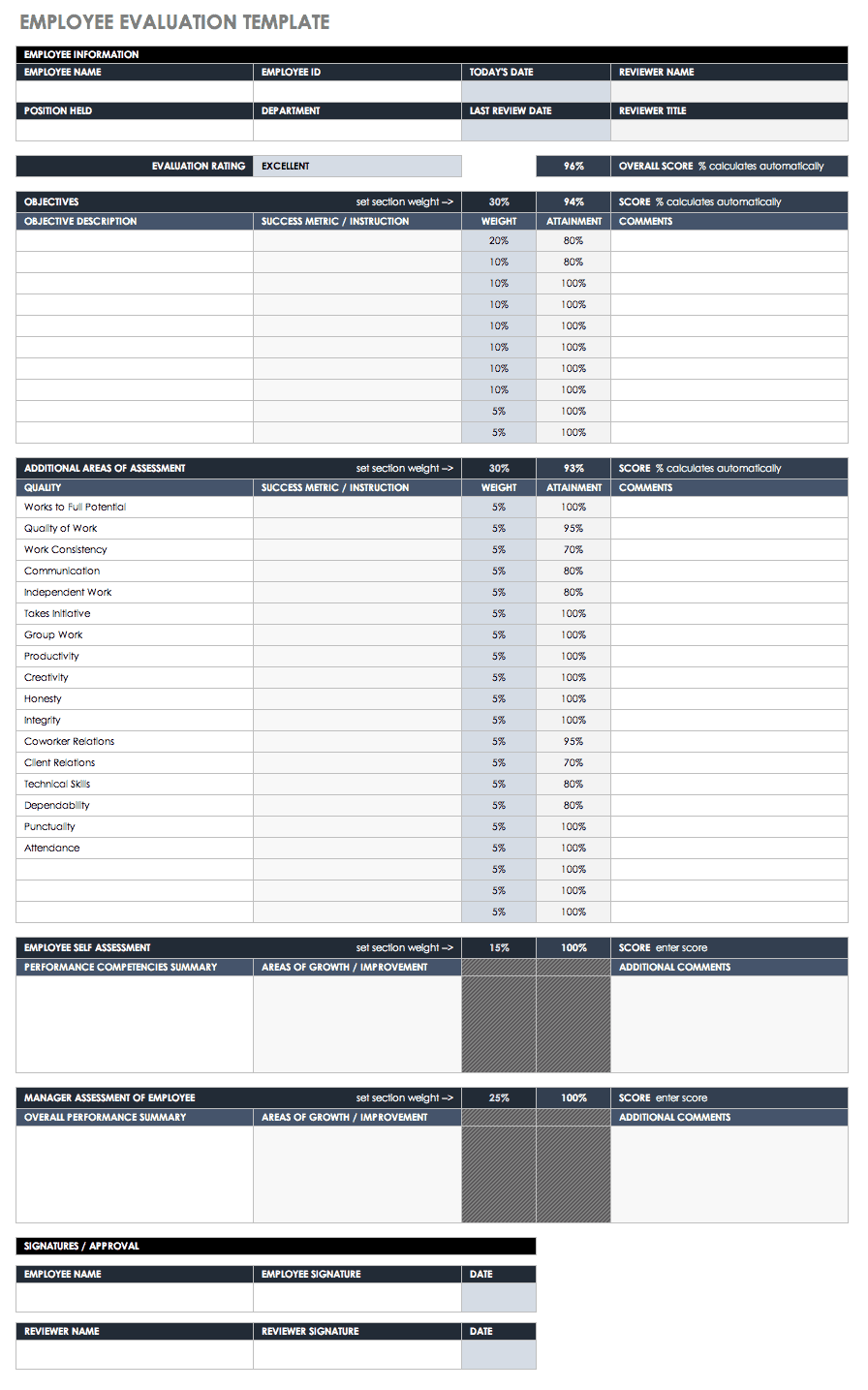
Download Employee Evaluation Excel Template
Excel | Smartsheet
Step Three: Forecast Demand
Forecasting human resource demand involves estimating the number of future employees of the right quality and quantity, with a view to the company’s strategic plan over a given period of time. Forecasting demand is the most crucial part of human resource planning and the most daunting. It’s challenging for many reasons, and even more so because there are no absolute answers on how to accomplish it.
There are two categories of forecasting methods: quantitative and qualitative. You can use both methods to track the work performance of the workforce as a whole, individuals, or business units. Qualitative reports contain anecdotal observations, while quantitative data is statistical or more data-driven. Select the methods that make the most sense in your environment. For example, in a non-manufacturing company, the work-study method which calculates the necessary working hours to produce units may not make sense. By gathering both quantitative and qualitative information, you can identify issues that are impacting your business's productivity, and then develop a well-rounded forecast to increase the company's efficiency, ensure you’re not over or understaffed, and understand future needs.
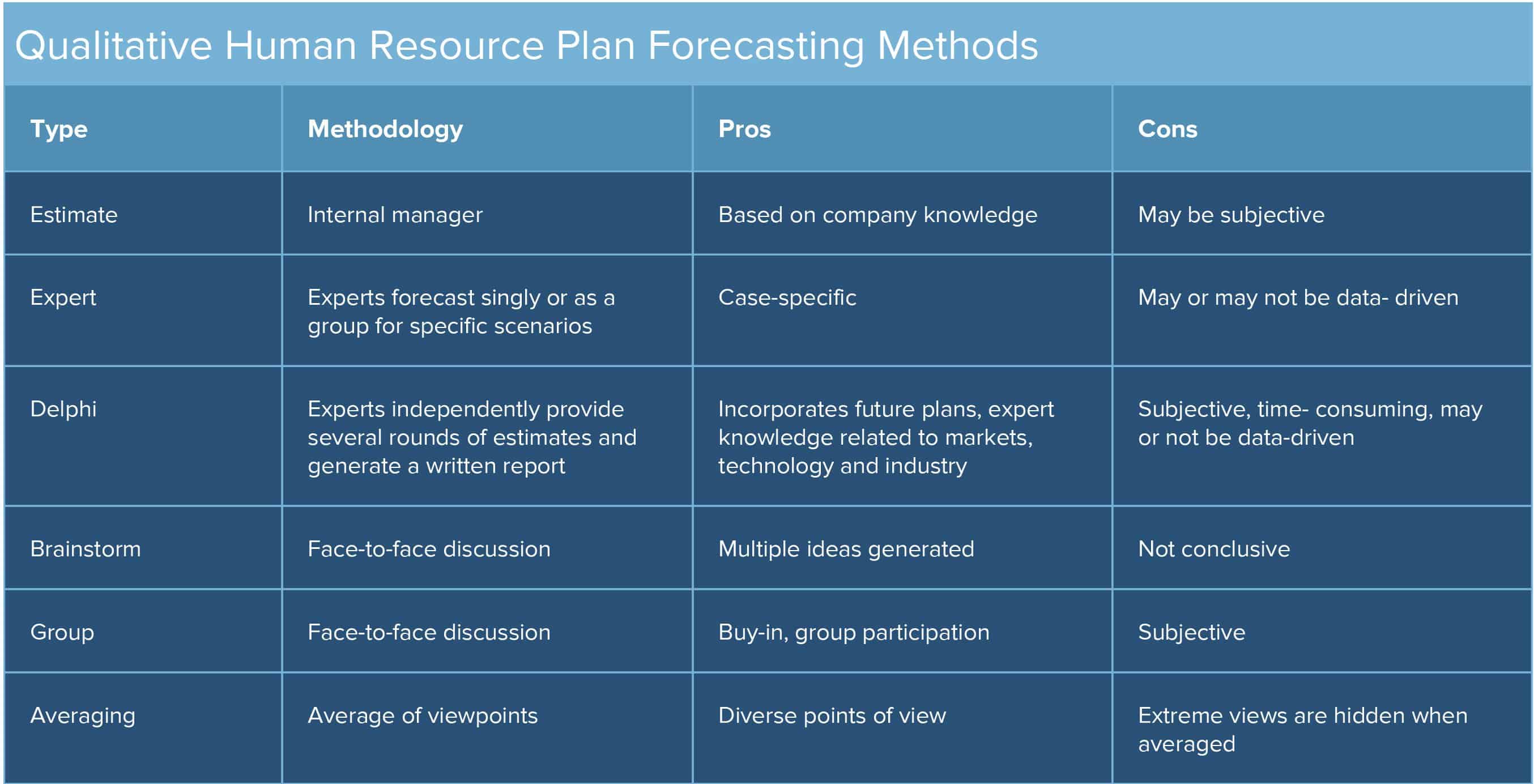
SWOT Matrix Template
The classic SWOT layout provides a clear view of your compiled findings as they relate to your human resources plan. The template also includes a column for rating the importance of each item by category so you can have a clear understanding of how the analysis elements compare and which will need the most attention. You can add Excel worksheets to hold supporting data and clarify the basis of your findings.
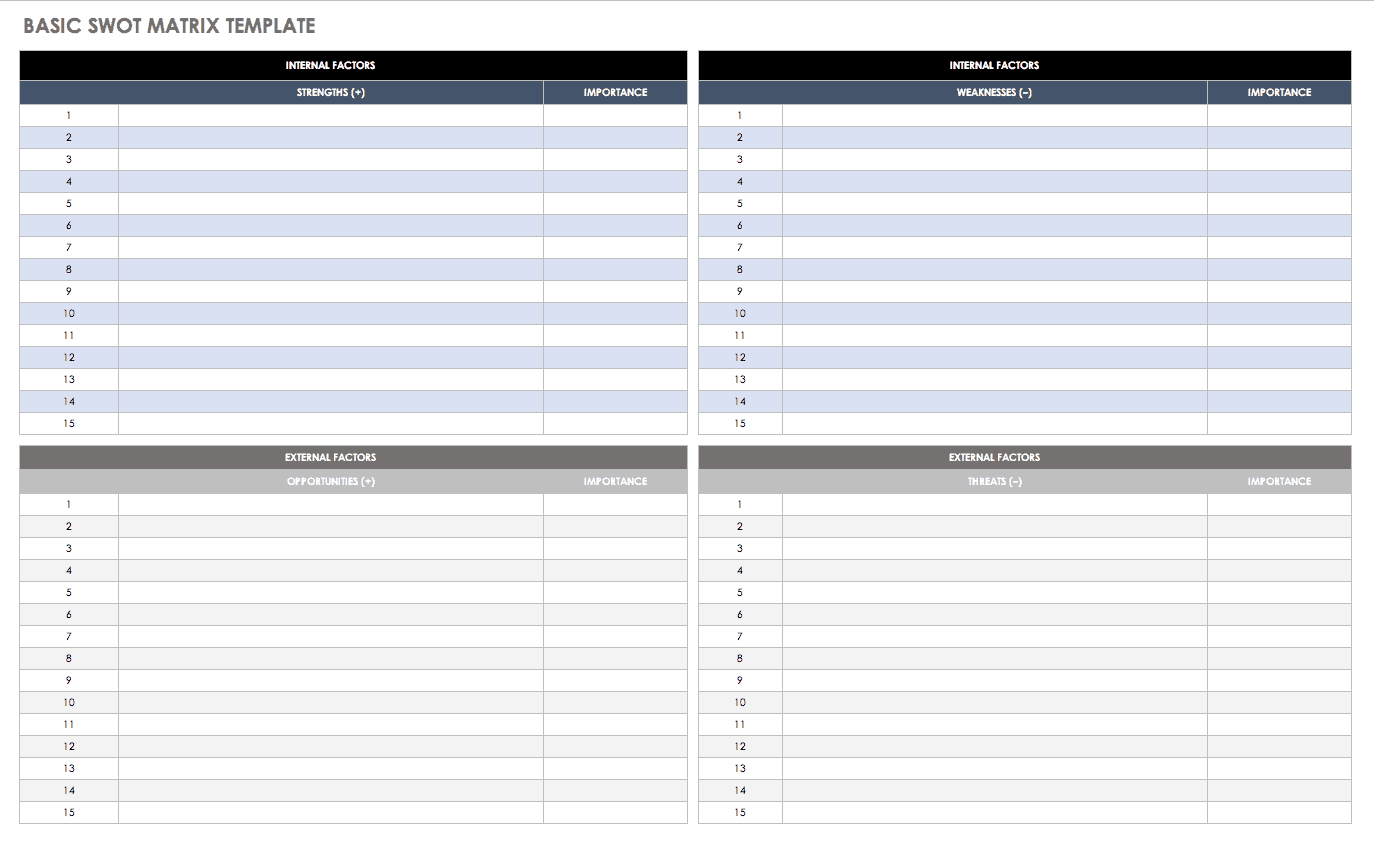
Download Basic SWOT Matrix Template
If you’re looking for different formats in Excel, PowerPoint, or Word, you can find free SWOT templates here .
Step Four: Estimate Gaps
With your forecast completed, you’ll have an understanding of future needs and if you will need to fill them with external workers hired full-time, part-time, or as contractors. If you have the right number of employees that don’t have the right skills, you can use training and development to upgrade employee skills to fill the gaps, or you may need to deploy workers in another role.
Employee Training Plan Template
Training is relevant for both employee success and team member retention. Though training takes time and effort, it's essential to have a plan in place to ensure a productive ramp-up period for new employees or existing employees who are learning the tasks and responsibilities of a new role. With this adaptable employee training schedule template, you can create training activities lists, add details about which team members need help to complete each task, track status, and provide a way for the manager and employee to enter feedback.
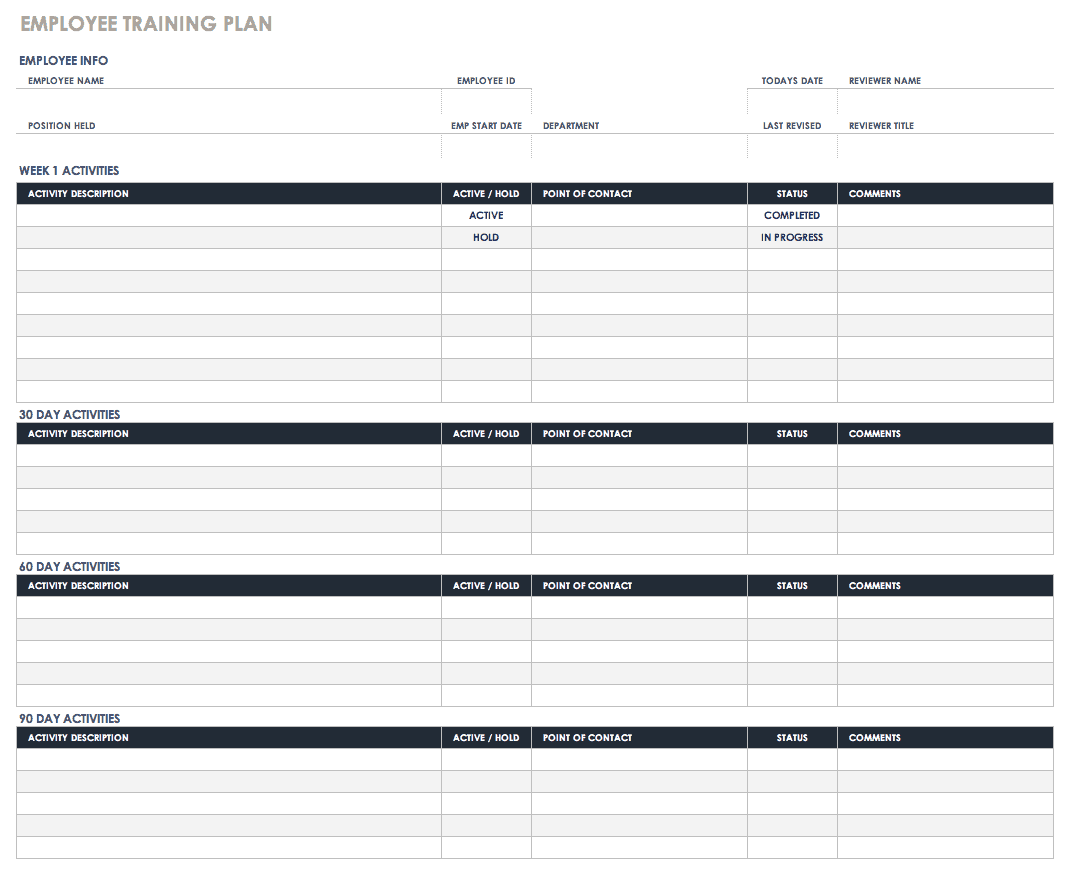
Download Employee Training Template
Transition Plan Template
Moving team members to fill different roles can be the ideal solution to filling workforce gaps. When making these changes, ensure that you maintain the information and knowledge the employee had in the initial role. An employee transition plan keeps the information accessible and easy to share. You can also use this transition plan template to assist the person previously in the role train any new team members. Input every aspect of the role that will be useful in the present and future.
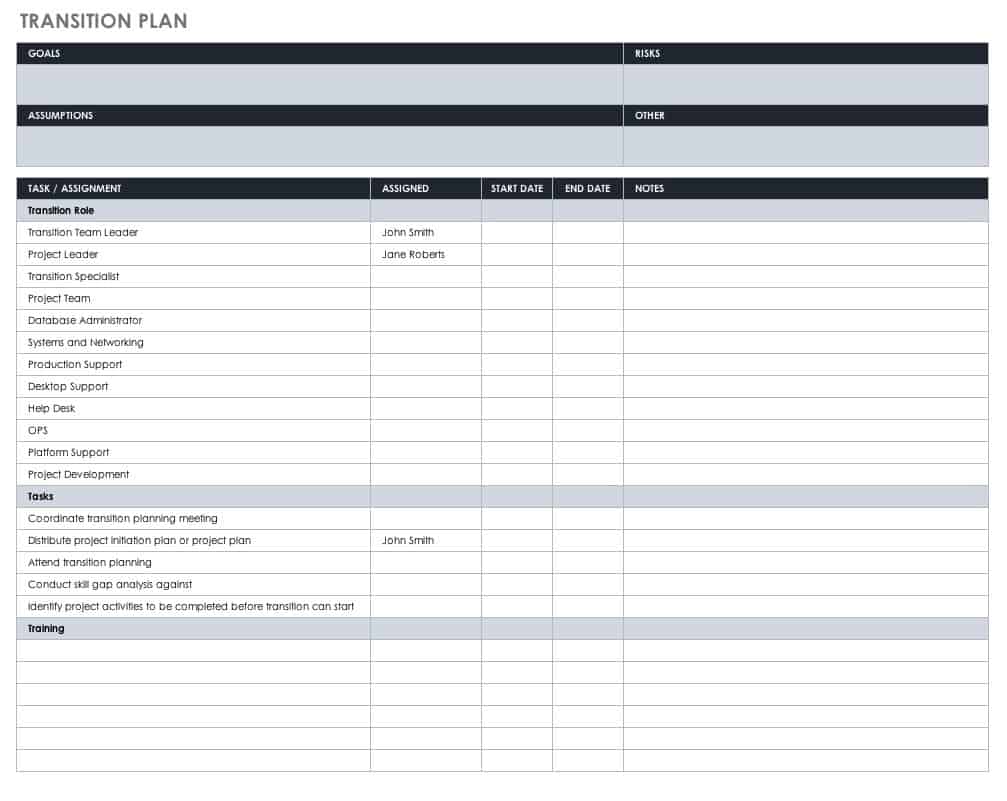
Download Transition Plan Excel Template
Step Five: Formulate the Human Resource Action Plan
The human resource plan relies on identifying deficits or surplus in the company. You’ll need to determine if you need to begin recruiting or training, transition, or develop voluntary retirement processes and redeployment in case of a surplus. Include priorities and critical planning issues in your plan.
Action Plan Template
This action plan template provides sections for goals, but you can add more sections to customize it to complete your human resources plan. Goals are translated into actionable steps that you can track to check progress. Assign start and end dates for each action, and take notes about each part of the plan.

Download Action Plan Template
Word | Smartsheet
Step Six: Integrating/Implementing the Plan
This is the most challenging aspect of any human resources plan. The organization often invests time and money on plans that are shelved and not utilized. Company executives need to grant buy-in, embrace the plan, and bring the organization on board. Overcome any potential employee resistance to the process by rolling in one aspect of the plan at a time to help employees acclimate to changes. Staffing or Recruiting Plan Recruitment is one of the top responsibilities of any human resources team. Searching for, vetting, and finding the right talent to join your team are all crucial steps to ensure the success of your organization. Having a staffing plan in place makes your team aware of the available recruitment sources, hiring goals, and budget. Use this staffing plan to organize all staffing details with columns for budgets, hiring goals, status, and comments.
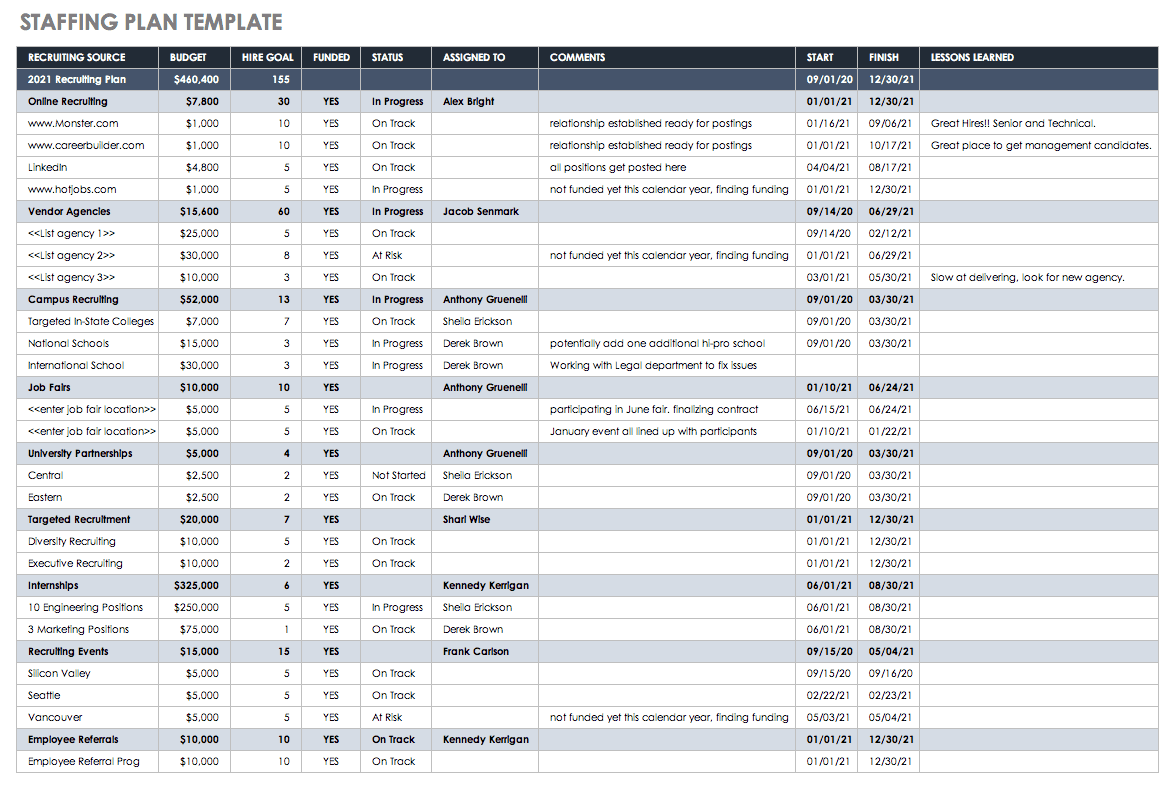
Download Staffing Plan Excel Template
Candidate Screening Tracker
If you don’t have an automated system, you can track and manage applicants’ cover letters, resumes, applications, and details about job openings. Tracking this information can be a lot of work depending on the size of the company and current hiring plan. Use this candidate tracker template to organize candidate documentation and details, and ensure that you provide a positive experience for candidates and people involved in the interview process. Track candidate contact information, phone interview questions and answers, status, comments, next steps, and more using this template.
Download Candidate Tracker Excel Template
Onboarding Plan Template
Onboarding ensures proper training and enculturation for new team members, and is also a powerful retention tool for any organization. Develop your own onboarding plan by using this template to plan activities at each stage of the process. Since a full year of onboarding is a best human resources practice, this spreadsheet shows tasks assigned to individual contacts over a twelve-month period. Add or remove columns to create a comprehensive onboarding plan.
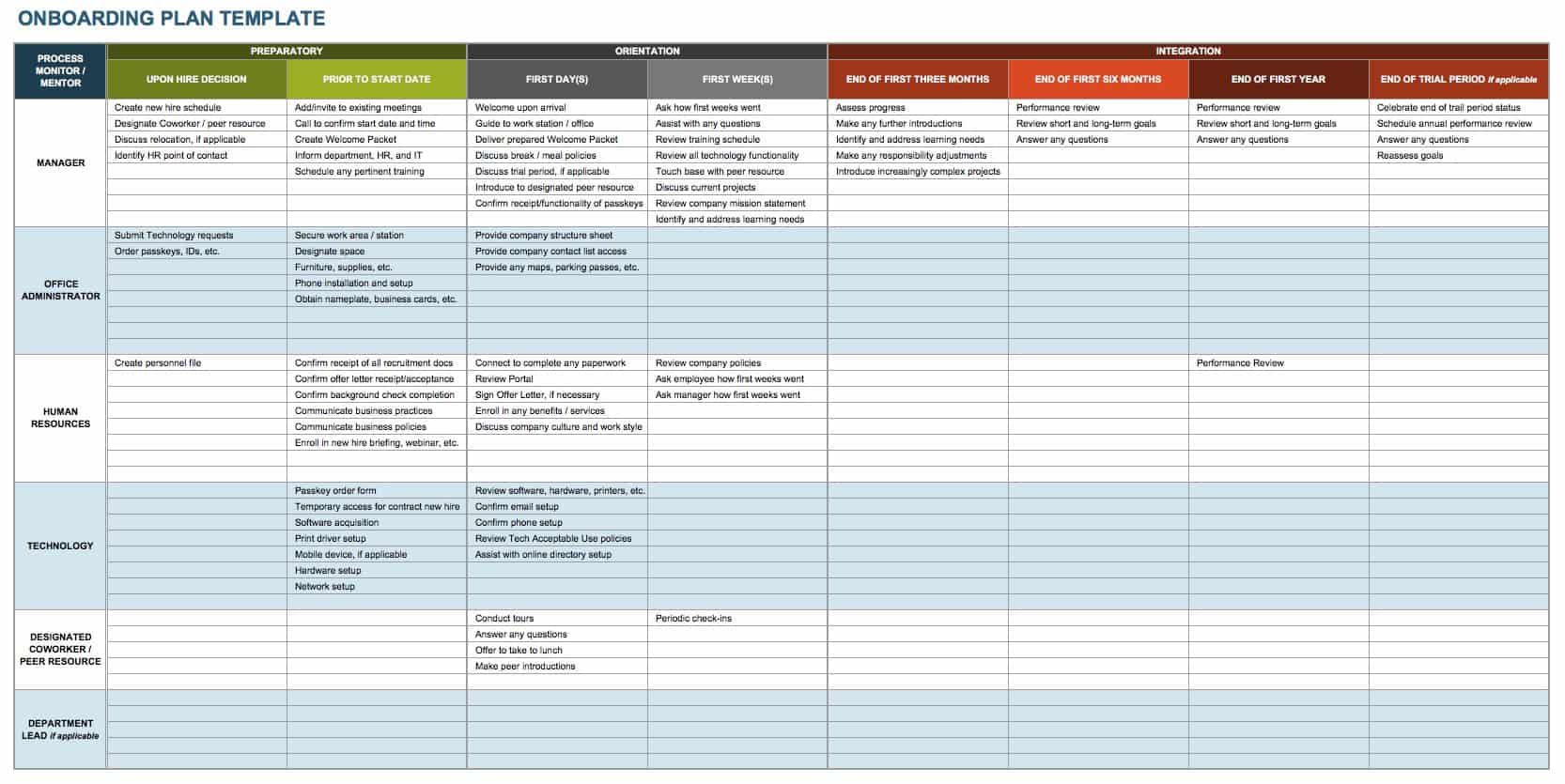
Download Onboarding Plan Template
For more best practice information and free templates to support your human resources planning, read Top Excel Templates for Human Resources .
Step Seven: Monitoring, Control, and Feedback
Strictly monitoring progress helps identify sticking points in your plan and helps you avoid making changes too quickly. It’s essential to compare actions to how the plan is being implemented to ensure fidelity. The human resource plan is an evergreen document that takes changing circumstances into account. Ongoing measurement, reporting, and continuous improvement efforts will keep the company moving towards its stated strategic goals.
Project Management Dashboard Template
Monitoring all the changes you need to while executing a complicated human resources plan can be time consuming. With this customizable project management dashboard, you can compile every aspect of the process, share status information with management and other team members, and view the big picture at a glance.
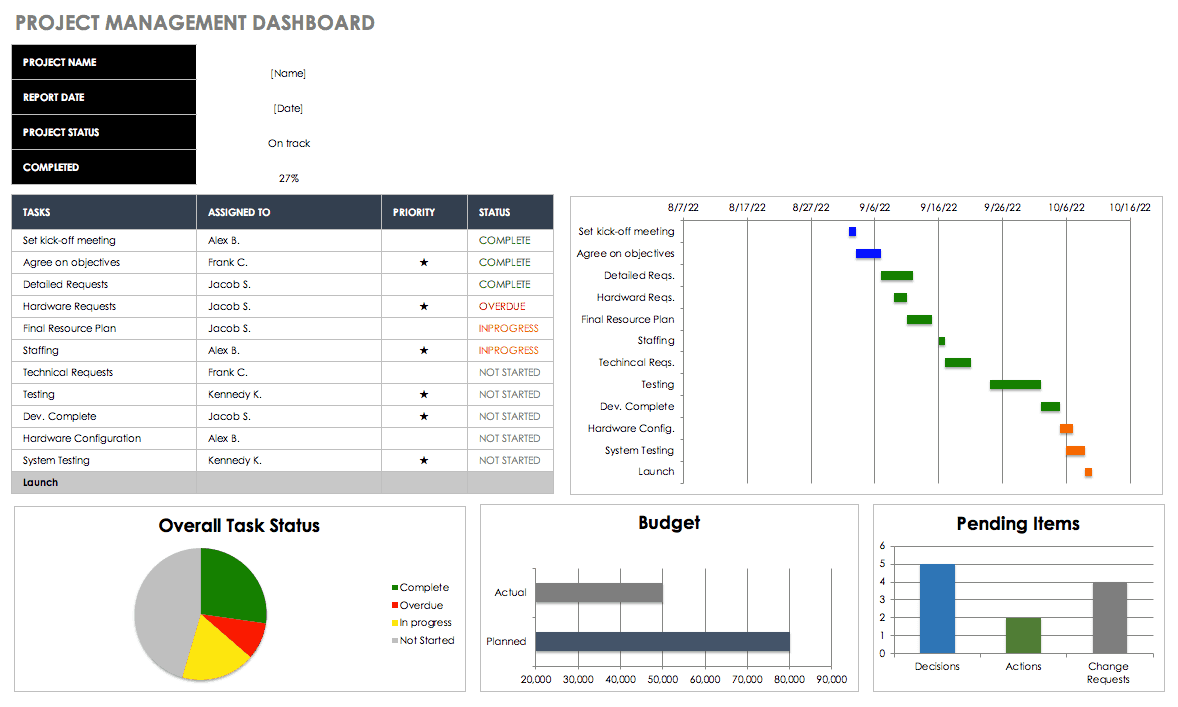
Download Excel Project Management Dashboard
Forecasting Is an Ongoing Process
“HRP plans should be reviewed annually, just after the business completes its strategic planning and forecasting for the year,” says Handrick. “For example, if the business plans to open an additional manufacturing location, or offer additional services requiring tech skills not currently in place, then HR will come along and provide estimates as to how many FTEs, what roles, and what kind of skills will be needed. HRP helps with the budgeting for the next fiscal year, and once approved can get to work filling those roles. In a fast-moving environment, HRP may need to be updated with every major change. For example, let's say your organization is project based and you just won a huge contract. Right away your HRP team will need to work with project managers to estimate staffing needs, whether temp or permanent, contract or hire.”
Human Resource Planning Round-Up: Best Practices and Expert Insights
Our experts share their thoughts on some additional issues to keep in mind as you develop your own plan:
- The Importance of Policy Planning: Company policy supports your human resources plan. Policies such as employment classification, benefits, compensation, performance, and improvement are designed to target not only the selection, training, and support of team members, but also to provide guidelines for conduct in and out of the work environment and many other aspects of employment.
- Social Media as Friend and Foe: Social media sites like LinkedIn and Twitter can be powerful recruiting platforms and a friendly, fun way to communicate with team members. However, they can also potentially be an issue when disgruntled employees or competitors get into negative commentary. It’s important to be alert to your company’s social media profile and to take corrective action when the buzz may not be favorable to your goals.

Sharon Margules, MA, CPC, ACC and CEO of Margules Leadership Consulting says, “The ability of a business to achieve its strategy is largely based on the talent it has to execute. While market and competitive forces can significantly impact the capacity of an organization’s pursuit of its strategy, the explicit capabilities of those doing the work will determine if the result is a success or failure.”
- The “New” Human Resources Professional: “Ultimately, a good HR person is a good business person,” says Adler. “The best HR professionals are system and integration project managers who understand deadlines and highly complex projects. A great candidate has business experience in something other than HR. In my consulting work, I’ve told CEOs that they should look for HR managers with a business background. I think it’s an important consideration, particularly for large firms.”
- More About Markov Predictive Analysis Modeling: One of the most difficult analyses to execute and potentially one of the most valuable tools in forecasting is the Markov model. It’s not a quick fix, but for most mid-to-large companies, it’s worth the time investment to learn how to execute it. For a detailed explanation, read A Markov Model for Human Resources Supply Forecast Dividing the HR System into Subgroups .
- Leadership and Succession Planning: “HR plays a critical role in enabling leadership, in mature or scaling organizations, to anticipate and understand the talent capabilities that will be necessary to meet their strategic objectives,” says Margules. She lists four items:
- HR should have a seat at the table when the strategy is being conceived to align on what capabilities are needed, and by when, to realize the strategy.
- HR needs to influence progressive and aggressive budgeting for resource acquisition, training, coaching, and development every year.
- HR must institutionalize effective succession and talent planning practices at all levels, and build an adaptive organization that can flex its structure to optimize performance.
- HR must use far-reaching ideas to retain its key talent and sustain a highly-engaged workforce in a diverse and driven culture.
- Plan Implementation: “HR plans should align with business strategy and annual plans and should be adaptive to a volatile and uncertain business climate,” says Margules. “While many organizations take a reactive, in-service approach to HR planning and determine their priorities and plans largely in support of annual plans, the most effective organizations are proactive: They anticipate needs and build plans that achieve short term and long term objectives. They adopt progressive practices such as allocating a portion of the staffing budget and resources to recruit and hire key talent for future-focused work. And, they have enough foresight to invest in high potential programs at multiple levels, entry-level accelerated development programs and coaching to build pools of qualified talent for future growth plans.”
- Buy HR Planning Tools or Do It Yourself? “The problem with traditional human resource planning is that it often hasn't supported the scalability of a growing business,” says Burr. “This is precisely why we have to consider new models for talent management, organizational design, and learning and development to ensure that our human resource planning processes can be flexible to meet the scaling needs of the business. This is part of the reason why you have seen an explosion of people analytics tools in the HR marketplace. It is to fill the demand for flexible and scalable models that provide the needed tools for business leaders to plan their people needs as the business grows.” Adler concurs and says: “I think a spreadsheet can often do a better job. Workforce planning has been around a long time. I think the main point is to be proactive and less reactive in the planning process.”
Five Challenges to Human Resources Planning and Implementation
“People are naturally change- and-risk-averse. Planning and proper support by HR and the people they hire need to happen 100 percent of the time,” says Adler. More often than not, there are some challenges involved in human resources planning and implementation. Here are the five main hurdles:
- Forecasting Is an Imperfect Art: Human resource planning relies on forecasting and supply, which can never be a 100 percent accurate process.
- Resistant Workforce: Employees may feel that their workload will increase, so they resist the process, or they may be uncomfortable altering familiar patterns in their work life and tasks.
- Ambiguity and Rapid Change: Uncertainties such as labor absenteeism, employee turnover, seasonal employment, technological changes and market fluctuations all affect planning.
- Inefficient Information Systems: Human resource information systems need to be reliable, comprehensive, and up to date. It makes it difficult to plan without good data about current employees.
- Cost and Time Factors: With all of the work hours involved in completing and repeating the seven steps, human resource planning is a time consuming and expensive process, so companies sometimes avoid it altogether, despite the benefits.
A Look to the Future of Human Resources Planning
Here are some of the themes experts think will influence human resources professionals, their companies, and the people they hire in the near future:
- Going Global: Globalization, the export of U.S. jobs and the import of non-U.S. employees are already underway, as is offshoring (basing services or processes in different countries). “Globally planning can be complex for any HR professional,” says Burr. “It can be a stressful situation for offshoring and outsourcing of jobs within a firm. HR planning should involve a detailed assessment of the new location globally, the workforce demographics, industry competitors, laws and regulations and the potential impact on U.S. jobs. How do we communicate? How do we train? This will all vary by organization, but a strategic HR plan that communicates the information can lessen the impact. With a sound and detailed HR plan, recruiting, retaining and growing talent within the organization will be much easier.” “Expect more offshore jobs, outsourcing and contract hiring because frankly they’re cheaper, and in many disciplines like finance, IT, marketing, can do the same work for less,” says Handrick. “Other than providing training for supervisors to manage off-site work teams, there's really no difference for HRP except where the line item goes on the plan. For instance, if you know you'll need 12 FTEs next year, and can get four of them offshore, that line item goes to 'expenses' rather than to 'salary' for the remaining eight.”
- More Technology: Social media will likely be in higher use to reach potential workers, particularly millennials who use Twitter, LinkedIn, and Facebook in their job hunts. Telecommuting and the use of social collaboration tools and video conferencing apps will keep people working and in touch with company culture. Emerging platforms will further streamline basic human resources functions to make onboarding and professional development more cost-effective and accessible from anywhere in the world for a virtual workforce.
- Big Data: Metrics and in-depth analysis of processes and people will become increasingly important in human resources as they are in other functional areas. Data- driven decision making is the future, as are metrics to show ROI in people and technology.
- Security Issues: All this new technology brings up security concerns for employers and employee. Data breaches are a fact of life, and the threat to personal data security, company security, and supply chain risks will likely continue.
- Health Care Costs: Costs are likely to continue increasing, since they have been rising steadily in the last several decades. New legislation will perhaps slow the costs of health care. In the meantime, strategies to lower employee healthcare costs will likely take the form of initiatives to improve employee health, and taking advantage of health reimbursement accounts (HRAs) that are consumer-driven or health savings accounts (HSAs).
Improve Human Resources Planning with Smartsheet
Empower your people to go above and beyond with a flexible platform designed to match the needs of your team — and adapt as those needs change.
The Smartsheet platform makes it easy to plan, capture, manage, and report on work from anywhere, helping your team be more effective and get more done. Report on key metrics and get real-time visibility into work as it happens with roll-up reports, dashboards, and automated workflows built to keep your team connected and informed.
When teams have clarity into the work getting done, there’s no telling how much more they can accomplish in the same amount of time. Try Smartsheet for free, today.
Discover why over 90% of Fortune 100 companies trust Smartsheet to get work done.

Unit 22 Human Resources Planning Assignment

Introduction
For the long-term success organizations are dependent on the significant role played by HRM because of competitive business environment and the need to survive the market competition. Organizations mostly rely on its capability of countering the rapidly changing business scenario that is both aggressive and unstable. With the emergence of modernization in business, one can see a tremendous change in the HRM approaches which has moved ways ahead of the traditional personnel management towards a can-do approach. Today, HRM is just not restricted to dealing with employees but has expanded in playing a key role in choosing the best potential employees through recruitment and selection, driving their personal and professional aims by aligning it with organisational goals.
Organizations can gain competitive advantage by endorsing the policies, processes and practicesof effective HRM thereby, producing committed workforce eventually making significant contributions in the overall business growth. This assignment will focus on understanding the importance of HRM in various aspect of work life through its numerous theories and practices.
One can describe HRM as a vital and systematic approachthat organizations adopt for managing its most valuable asset in the form of employees who are the key contributors either independently and collectively for attaining the business objectives. HRM is an organizational function mainly dealing with issues like recruitment, pay and performance management, employees’ safety, wellness, benefits, training and motivation, organizational development, communication and administration.(ITKnowledgePortal, 2016)For example, Coco Cola has conceived a cognitive terminology ‘Think globally, Act locally ’ further depicting its cross border management outlook thereby, building a new critical role for the HRM functions granting the brand the privilege of doing business with its subsidy markets. Furthermore, Coca Cola encourages its employees in participating and sharing their learning hence, has created and implemented a robust HRM function amid the employees at all levels and eventually succeeding in spreading its ideology at workplace.(Alsaif, 2015)
Personnel management, on the other hand can be described as to obtain, use and maintain a workforce, which is satisfied. Moreover, PM is a significant part of employee management and the employer-employee relationship. With PM’s role heightening over time, global car manufactures like Nissan Motors for example, are making the best use of it to build a key relationship with trade unions because the management understands the savings it can make by centralizing the employee related processes. It has also helped Nissan in unifying and upgrading its CSR activities and voluntary social care programs.(MSG, 2016)
Differences between HRM and PM:
With the emergence of modern day business HRM is not just limited to personnel administration anymore but rather is considered as a centralized and omnipresent management function eventually executed by specialized personnel. (CreativeHRM, 2016)
The process of valuing and employee development is known as HRM and comprises of recruitment and selection, employee engagement and communication for retaining them, leadership, training and development. The key objective of HRM is aligning employees’ personal and professional goals with that of Coca Cola. The HR department at Coca Cola emphasizes on proper planning where every employee can coordinate his/her career path with the fulfilment of organizational goals. For employees it is essential that they remain motivated for achieving higher business goals of Coca Cola hence, the HRM functions exercised at workplace focus on human resource planning to provide employees with more opportunities thereby, enabling them in getting promotions and growth. HRM functions within Coca Cola further determine its requirement of human resources and simultaneously identifying their training needs. (CreativeHRM, 2016) Through training Coca Cola can enhance the employees existing skills sets for meeting the organizational change thereby, managing its subsequent business goals. HRM functions ensure that being a global brand Coca Cola endorse various CSR programs, which should necessarily include lessening Coca Cola carbon imprintsfor benefitingEarth. HRM has driven Coca Cola encouraging and exercising green practices at its stores and warehouses, fostering a culture of social responsibility,celebrating successes and ultimately publicizing the activities amid the public.
Being an MNC, one expects Coca Cola’s HRM system to be robust, effective and efficient for successfully executing its functions discussed above. Moreover, Coca Cola’s HRM ensures that employees are motivated in giving their best performances. (Lokhandwala, 2016)
Roles and responsibilities of line managers are:
- Ensure that performance difficulties employees face are accordingly handledby working together with them for determining measures to be undertaken for improving performances.(HRSouthwales, 2016)
- To ensure that every employee at Coca Cola is aware and understands the consequences of not improving themselves and setting prudent and perceptible performance standards consisting of action plans, targets, standards, deadlines and support.
- Setting a feasible timeframe for employees’ self-improvement and regularly organizing progress review meetings.(HRSouthwales, 2016)
- Furnish fair support, supervision and employee encourage to drive them towards Coca Cola’s objectives.
Line managers have an integral role to play in Coca Cola’s HRM and their roles and responsibilities primarily revolve around employee engagement, performance appraisals, performance based pay and disciplining the employees. Since it is the line managers working closely with the employees they are aware of their plus and minus points thereby taking care of theirtraining and development and further acts as mediator amid the employer and employees and helping and managing them for achieving Coca Cola’s business objectives. Moreover, the roles and responsibilities played by line managers supports in smooth execution of HRM functions like recruitment and selection, appraisal, training and development, public relation, performance measurement etc. further ensuring that employee remain motivated, productive and competent.(HRSouthwales, 2016)
Legal and regulatory frameworks can be described as set of certain rules or guidelines imposed by the UK government which all organizations operating in the country are bound to adhere with. (Guest, Paauwe and Wright, 2012)
Positive and negative impact of legal and regulatory framework on HRM:
- Equal Wage : this act is followed at Coca Cola to ensure that all the employees in similar job roles and skills are equally paid without being gender biased. The positive impact of the act is it has allowed Coca Cola to emerge as the most preferred place to work for employees especially the females whereas being discriminative in paying equal wages, Coca Cola will invite legal penalties and decline of the brand’s market image, hence, impacting negatively.
- Minimum Wage : this act allows the employees to seek minimum wage from Coca Cola who understands the importance of adhering to it. Under the act, an employee above 21years is likely of getting £7.20/ hour while employees belonging to18-20 years should be paid £5.30/ hour. Coca Cola ensures that it employees are paid the minimum wage which makes them one of the best places which follows employment laws and seeks employee welfare at work hence, impacting positively whereas the negative impact can be Coca Cola might fail in establishing ethical work practices thereby, employees exploitation.(Guest, Paauwe and Wright, 2012)
- Data Protection : this act empowers the employees in knowing the information Coca Cola holds about them and ensure that the information held will never be mishandled and made public. The positive impact is that it restricts the HR department from exploiting employee information for Coca Cola’s benefits. In case, Coca Cola is found guilty of mishandling employeeinformation can face legal actions hence, impacting negatively. (Guest, Paauwe and Wright, 2012)
Get assignment help from full time dedicated experts of Locus assignments.

One can describe Human resource planning as a process in which the HR department of Coca Cola can efficiently plan its functions and the operationsin advance for averting emergency situations. Since past few decades HRP has emerged as an integral part of HRM practiced in organizations. Coca Cola through HRP can ensure that it always enjoys the perks of having the exact number of employees having appropriate skills. HRP allows Coca Cola to meet the demands and supply of workers in labour market. (Majumder, 2014)
Coca Cola through HRP can easily identify the current capabilities of the employees and the ones they need to possess i.e. gap analysis to attain the organisational goals and overcome the market competition. The key purposed behind Coca Cola using HRP is prediction of the number of employees it might in future for expanding its operations or improving the existing services. Moreover, HRP allows Coca Cola to evolve its understanding of the labour demands and supply .Much of Coca Cola’s global success can be credited to the effectiveness of its HRM functions where employees are promoted as the face of the business. Coca Cola emphasizes on HRP for acquiring personnel with functional skills, knowledge and experience to smoothly execute its everyday operations. Through HRP, Coca Cola keeps itself prepared tracking the number of employees reaching the retirement age and filing the positions immediately.(Majumder, 2014)
Coca Cola needs HRP while making business expansions and locating the areas where more than required number of employees are there and vice-versa.
Stages involved in the planning of human resource requirements:
- Assessing Human Resource: in this stage the HR Manager of Coca Cola determines the current manpower strength it owns across all its stores and which internal and external factors influence its business. This makes easier for the management to conduct a business SWOT.
- Demand Forecasting: HRP allows Coca Cola in identifying the demand and supply of labour market thereby, evaluating the exact number of employees the business will require in impending future and the resources of engaging the potential employees. It is important to effectively and clearly understand Coca Cola’s business strategy andfuture objectives for forecasting the labour demand in coordination with the organizational goals and planned business strategy.(AccountingManagement, 2016)
- Supply Forecasting: Coca Cola’s HR department identifies the labour supply by considering the internal and external supply of workers. Coca Cola avails the internal supply of workers either by transferring employees, promotions, job enrichment etc. while it can avail the external supply of workers from labour market and hiring.(AccountingManagement, 2016)
- Matching: Coca Cola’s HR Manager matches the demand and supply of labours. In case of surplus workforce, Coca Cola might take measures of removing them whereas in shortage, it would indulge in recruiting to fill the vacant positions.
- Action plan: finally, once the identification of surplus and shortage of human resources is done, HR Manager can implement adequate plans for resolving the problems.
One can describe recruitment as a process to find and hire the best and qualified applicants either from in-house or external resources for filing up a vacant job position in a manner that is timely and cost-effective. The process further comprises of evaluation of job needs, intriguing potential employees, applicants screening and selection, hiring and new employees integration within Coca Cola. The process of selection involves choosing of a suitable candidate from hundreds to fill the vacancy. (Mayhew, 2016)
- Process of recruitment and selection:
- Coca Cola’s recruitment and selection process: The process at Coca Cola is designed for being profound and far-reaching with an aim to provide the applicants with a great experience. The various stages of the hiring processallow in understanding the candidates and offer them with a scope to experience the practical working life at Coca Cola. The process is fair where transparency is maintained and applicants’ queries are promptly responded and are guided throughout. (Coca Cola, 2016)
- Coca Colanever asks the applicants to share their personal information or any payment for applying. The job advertisements on partner websites and job portals like MonsterUK, jobs.ac.uk, Fiverr etc. directly take the applicant to Coca Cola’s corporate website. In the first stage, applicants CV’sare screened and are allowed to complete the process through a form submission. Applicants applying for a sales job need to complete a Talent Screener questionnaire and the successful ones are requested to attend a telephonic or videointerview. The applicants who pass the round are forwarded to assessment centre where they participate in a group interview. An interview with the line manager is then organized for the shortlisted candidates who if chosen are informed through an email notification. (Coca Cola, 2016)
- Tesco’s recruitment and selection process: Screening of applications is the vital stage of Tesco’s selection process to ensure that shortlisted candidates fulfil the job requirements. The career section in Tesco’s corporate website has an additional tool naming 'job type match' making searching of jobs easier for the applicants. (BusinessCasestudies, 2016)
Applicants surpassing the screening round are invited to attend the any of Tesco’sassessment centre which provides flexibility in the selection process. The shortlisted applicants are grilled through various parameters like teamwork, problem solving etc. and the finally survives are requested to attend final discussion round with the HR and line manager and the job offer is made.(BusinessCasestudies, 2016)
One can observe that although there are similarities within Coca Cola’s and Tesco’s recruitment and selection process there are also certain variations. Coca Cola’s process is much more pertinent when compared to that of Tesco because it assess the abilities of applicants through online questionnaire and rejects those who fail the test thereby, saving much of time and in cost effective way.Moreover, through the online questionnaire Coca Cola can easily evaluate theapplicants’ personality traitsand recognize their attitudes, team spirit etc. ahead of moving forward to second phases. (Schatz, 2016)
In Tesco, the HR Manager conductsinterviews for understanding the abilities and personality traits of the applicants which means been involved physically. The HR Executives have to manually shortlist the bests from hundreds of applications they receive which are time consuming and painstaking. However, Tesco’s processof skill testing is more effective compared to Coca Cola because it puts the applicant in real time scenario in any of its stores for evaluating their problem solving skills, working under pressure, customer dealings etc. (Schatz, 2016)
One can describe motivation as forces that drive human behaviour and actions either as an individual or employee hence, Virgin Media should understand and identify the factors motivating them and fulfilling them efficiently for extracting desirable employee performances. Theorists have proposed various motivational theories for dealing with employee motivation. At Virgin Media, employees are kept motivated by keeping them engaged and firmly believes in rewarding thereby, offering its employees with competitive pays and reward schemes like ASPIRE field pay. Virgin Media pursues Mayo’s theory of human relations and hence, has introduced recognition programs like NPS Hero Championship scheme, SHOUT scheme and VOICE giving employees a platform for sharing their views and opinions. (Alegbejo, T.B., 2013)
Motivation at Tesco Plc is steered by Taylor’s scientific theoryand has introduced an Employee Reward Program which is in line with the theory. Although Tesco focuses on non-financial rewarding system, Taylor’ Scientific theory give a solid base to the management practices aimed towards employee motivation. Every year a survey known as Viewpoint is organized where the employees are encouraged for taking part and expressing views about their experiences at Tesco. Other than Taylor’s theory, utilization of Mayo’s human relation theory has empowered Tesco in cultivating communication between line managers and floor staffs through team meetings, 360 degree feedback and designing a PPD plan for them. (Alegbejo, T.B., 2013)
One can describe Job evaluation as a methodical process used for determining the relative worth of jobs with organizations like Virgin Media and Tesco. It further helps organizations in identifying an adequate pay structure and designing unbiased grades for managing the jobs and paying comparatively to the employees. (Bratton and Gold, 2012)
The process of Job Evaluation process within Virgin Media relies on the competitive remuneration packages offered by the competitors apart from its internal tall organisational structure. The lower level employees are given less compensation in comparison to the higher level employees. Non-analytical method is used by Virgin Media for jobs classification and ranking them according to their level and roles within the organisation.
Factors determining pay in Vrigin Media:
Organisation Size: size has an important role to pay in employees’ compensation because pay reduces if the company size is big as profits generated has to be distributed amongst more number of employees and vice-versa. However, for Virgin Media it is important to compensate proportionately to its competitors despite of itshuge size.(Bratton and Gold, 2012)
Level: Virgin Media follows the theory of Maslow hierarchy of needs for compensating the employees because of its hierarchical nature. The employees serving at lower levels are paid comparatively less for fulfilling their needs whereas employees at higher levels are paid according to their seniority and experiences
Skill and experience: Virgin Media is always in need ofemployees with specific skill set and experience hence, the newly recruited employees are paid based on prior packages which may vary when compared to the existing employee at similar position. (Bratton and Gold, 2012)
Profitability: Virgin Media distributes profits amongst employees based on its annual business performance thereby, their pay is determinedbased on the generation of profits
Employee performance: at Virgin Media, rewards are distributed based on employee performance further determining the employeespay structure.
Bratton and Gold has described reward system as blend of both intrinsic and extrinsic rewards organizations offer its employees apart from unified policies, administrative procedures and management practices in order to implement the system according to HR strategies and the organisational objectives (Legnerová, 2010)
- Extrinsic rewards : is usually the physical reward that Virgin Media distributes amid its employees and often an employee’s emotions are attached to an extrinsic reward because he/she values such rewards. This kind of reward is directly related to employees’ job performance. Pay, bonus, fringed benefitsfree life health and safety insurance, pension plan, employee discount scheme etc., promotion, profit sharing, improve working conditions are few examples. (BusinessTopia, 2016)
- Intrinsic rewards : are basically non-physical rewards which although cannot be touched but leaves an emotional impact on the employees and are also directly related to employees performance. Achievement, recognition, praise, work freedom are few examples.(BusinessTopia, 2016)
The rewards system been exercised in Virgin Media is a significant part of its HRM strategy further playing a key part in keeping the employees motivated. Virgin’s reward system focuses mainly on non-financial rewards referring to the fulfilment of employees needs and satisfying them with a sense of achievement, power of decision-making, team contributions and key role in driving the business towards desirable goals. Distribution of rewards within Virgin Media enhances employee motivation thereby, driving them to give their best performances. Reward system further empowers Virgin in retaining just not the employees but also the apprenticeships candidates by offering them a full-time position. Virgin’s reward system is highly effective in attracting young and dynamic talents to work with the global brand and gain lifetime experiences. (BusinessTopia, 2016)
Methods Virgin Media use to monitor employee performance are:
360° feedback : by using this tool Virgin Media empowers every employee in giving feedback about their colleagues and even superiors thereby giving employees more power and thus motivated. He/she can give feedback about team members, managers and subordinates which helps the management in monitoring employees’ performance.(Brown, 2010)
Personal Development plan : for monitoring the employee performance Virgin Media also encourages them to use PPD plan where the line managers set every employee’s objectivesand targets based on their skills and knowledge for a given timeframe. Once the time period expires, the achievements and growth are reviewed. This technique helps Virgin to maintain clarityamid employee and employer.(Brown, 2010)
Reasons for termination of Faisal’s employment contract with Chicken Master were his inadequate job performance. Bob had discovered that Faisal failed miserably in keeping the front of store and the kitchen clean and stocked which turned away many customers empty handed, staffs were not supervised, he used to take frequent time offs while work without notifying anybody. Faisal’s employment was also terminated because he lacked supervision skills despite of have 15 years of similar experience and would utilize much of business time in mailing his wife and assisting his daughter in her homework and would regularly watch pornography and violated the restaurant’s policy by taking away store’s equipments for personal use and even designing his own restaurant while at work. All these forced Bob to immediately terminate him
Other reasons are:
- Business Conditions: organizations might lay off employees because of adverse business conditions due to downfall of the economy. Employees might be permanently laid off or are often called back once the business improves.
- Absenteeism: employees who are indulged in regularly remaining absent from work are terminated if they failed to change despite of repetitive warnings
- Attitude and Behaviour: employees found guilty of practicing unacceptable behaviour at work either with their co-workers, vendors and customers are terminated after being warned. (Joseph, 2016)
Bob the owner of Chicken Master did not pursue any legal method while terminating Faisal from his employment despite of having valid reasons. Although, Bob had confronted him and has personally investigated, he failed to document them neither has informed Faisal about the decision in advance. He just terminated Faisal without following the employment exit procedures. (Ross, 2011)
Tesco’s employment exit procedures are regulated and more legal where everything is documented which works like evidences in case the employee file a legal suit against the company. During voluntary employee exit, the employee needs to submit an exit form citing the reason of exit with the last working day duly signed. The HR Manager then arranges for an exit interview where he/she tries in retaining the employee by offering benefits if that is the reason of exit, however, if the employee is adamant ofleaving, the form is passed and employee is informed to return office equipments, uniforms, documents etc. and a notification is send to the Accounts department for clearing the dues ahead of the last working day. (Ross, 2011)
To protect the employees from been exploited by the organizations legal and regulatory frameworks has been imposed so that employers cannot indulge into unfair or wrongful practices for terminating the employees.
- Wrongful Dismissal: Bob terminated Faisal’s employment without even notifying him in advance or even was not been compensated for the notice period. Hence, the dismissal process followed by Bob comes under wrongful dismissal. (Kahn, 2010)
- Unfair Dismissal: an employer needs to have fair reasons namely incapability, misconduct, illegality, planned retirement, redundancy for terminating employment. Furthermore, an employee should be warned ahead of terminating him/her. Bob only confronted and on investigated personally before terminating Faisal which he easily claimed unfair in court. (Kahn, 2010)
According to UK laws, Chicken Master is bound in giving job security and despite of being wrong Faisal claimed of being wrongfully and unfairly terminated since Bob had no written documentation or evidence against Faisal. In case Faisal allegation of been terminated because of gender discrimination proves, Chicken Master might face legal actions and will have to monetarily compensate Faisal.

Get Complete Solution From Best Locus Assignment Experts.
Through this assignment various aspects of HRM and its role and importance in organizations success is discussed. HRM emphasizes on organizations structure and policies for establishing aneffective communication process thereby, reducing workplace conflicts and confusion. Employee motivation is the key consideration of HRM for identifying the psychological approach enhancing employee behaviour. Organisations focus on employee motivation for maximizing the business productivity. Job evaluation and pay structure is also HRM’s prime consideration for allowing the employees understanding their job roles and hence, letting the business management in keeping track of employeesprogress.
Delivery in day(s): 4
- Number of views: 655
- Unit: Unit 21 Human Resource Management
Share this Solution

Other Assignments

Computing Skills Assignment Help
Delivery in day(s): 5

Organisational Behaviour Assignment Help
Delivery in day(s): 3

Business Law Assignment

International Management Assignment Help

Business Law Assignment Help
Related solutions.

Human Resource Development Assignment Help

Unit 21 Human Resource Management Assignment ABC Milk World


Managing Human Resources Assignment Marriot Hotel

Unit 21 HRM in Training and Development Assignment

Unit 22 MHR Assignment

Unit 21 Human Resources Management Assignment Sample
- Unit 1 Business and Business Environment
- Unit 1 Business Skills for e-Commerce
- Unit 1 Communicating in HSC Organisations
- Unit 1 The Contemporary Hospitality Industry
- Unit 1 The Travel and Tourism Sector
Other Solutions

Unit 6 Business Decision Making Assignment Help

Business Strategy Assignment Solutions

Managing Business Activities to Achieve Results Assignment Help

External Business Environment Assignment Help

Contemporary Issues in Travel and Tourism Assignment Help

Business Environment Assignment - British Airways

How to Write a Human Resource Plan

If your business is to succeed and grow, you need to ensure that you dedicate the time and effort required to develop a comprehensive human resources strategy. An important component of any successful human resources strategy is writing a detailed human resource plan.
If you are unsure how to write a human resource plan or unclear about the difference between human resource planning and a human resources strategy, you have come to the right place!
We start by clearly explaining what the difference is between HR planning and an HR strategy. From there, we describe how a business plan fits in with your overall business strategy and outline the items you should address when you write your own human resource plan.
What is the Difference Between an HR Strategy and an HR Plan?
A Human Resource Strategy: A human resource strategy outlines the long-term direction of a business and how it will achieve those aims from a human resources perspective. It takes the long-term goals of that business and ensures that the business’s human resources are moving in the appropriate direction to achieve those same goals.
A proper human resources strategy addresses talent retention and acquisition, as well as the hierarchy for that organization, succession planning, and how your existing employees will progress through it. Your strategic human resource planning should outline how your business will react to industry changes appropriately. Every business must align its overarching goals with its human resource strategy to succeed and grow.
A Human Resource Plan: Once a business has developed an overarching human resources strategy, it will need to write a human resources plan. Essentially, this document breaks down the various tasks and initiatives required to follow its human resources strategy.
The Difference: Your human resource strategy is your overarching HR goals and aims. It explains how your business aligns its HR efforts to succeed overall. On the other hand, the human resource plan is a document that lists the tasks and initiatives required to achieve the human resources strategy. It also outlines how to link the human resources strategy together with your business strategy.
Simply put, your human resource plan is a document that you will follow to make the goals set out in your human resource strategy a reality.
How Do You Develop a Human Resource Plan?
After completing a human resources strategy, it is time to write up a document that outlines how your business will follow that strategy and stick to its goals.
The following are some of the areas your human resource plan should cover:
- A detailed description of how your business will achieve the objectives outlined in your human resources strategy. This section of your human resources plan should come first. It needs to be a specific action plan that will list timelines for certain goals and objectives. You also need to include accurate budget requirements in this section of your human resources plan. If your funding does not line up with the aims of your human resources strategy, it is unlikely that it will succeed. For example, if an organizational goal of your strategic HR plan is to acquire new talent who will stay with the business long-term, your strategic objectives should address how to attract the workforce you want to hire. How will you advertise new positions, and what can you offer qualified applicants that your competitors cannot?
- How to react to the growth of the business from a human resources perspective. When you acquire a greater number of clients or customers, how will your business react? Will you hire new employees to handle the increasing workload, or will you work towards automation and upskilling your current workforce so they can handle more responsibility?
- A thorough breakdown of your business’s current capabilities, as well as a detailed forecast of your anticipated needs. What skills do your current employees possess, and what skills do you anticipate needing in the future?
- Detailed descriptions of how your business will go about acquiring new talent. This plan should give a thorough breakdown of the company’s compensation structure, its training and development system, performance appraisal, and performance management. Remember, you will not be able to hire the new talent to keep up with demand if your human resources plan is vague and incomplete. Human resources planning should also outline what you are looking for from new hires, including what traits they should have to fit into your business’s existing work culture. Recent labour shortages have made acquiring new talent more difficult than ever before. Your human resources plan should clearly state what you are looking for from new employees and how you will position yourself as an attractive employer to desirable candidates. Employee retention is also critical! Human resource planning should outline initiatives you will follow to retain the current talent you employ.
- Detailed descriptions of potential contingencies for when things do not go according to plan. Will your business be able to fulfil its payroll responsibilities during periods of hardship, or will you have to turn to external funding and layoffs? Do you have a strategic plan for outsourcing or contracting out some of the current or future roles your business needs to fill?
Final Words
The actual format your human resource plan follows does not have to be overly specific, but it is important that it is detailed and realistically describes how you will achieve the goals described within your human resources strategy.
For your business to succeed, you must consider human resources planning for every decision you make. Remember that human resource plans need to be updated regularly. While this plan should be comprehensive, you cannot be afraid to revisit it as your business grows and the market changes.
Once it is written, refer to your human resource plan regularly, as it will help ensure that your business is always moving in the right direction.

Related Posts

How to Develop an Effective Employee Exit Interview
Employee exit interviews are your chance to gain valuable insights from outgoing employees. Keep reading to learn what questions to ask.

Things to Consider When Creating a Parental Leave Policy For Your Business
A parental leave policy is essential to support your employees fully. Keep reading to find out why you need one.

Heat Stress Symptoms – How To Manage Heat Stress In The Workplace
Know what heat stress symptoms to look out for to ensure your workers’ safety. Learn what those symptoms are in this article.

What is the New Phrase ‘Quiet Quitting’?
Are you familiar with the term “quiet quitting?” Find out what it means and how it might be affecting your business.
- Employee policies
- HR Consulting
- HR Planning
- HR Strategy
- Recruitment
- Uncategorized
- Whitepapers
The Easy Guide to Human Resource Planning with Tools & Templates
Updated on: 23 June 2022
It’s no secret that the key to the continued smooth operation of an organization is its employees – well, the right kind of skillful employees doing their job right. And the way to get that kind of employee working in your organization can only be made possible through proper human resource planning software .
In this post, we have simplified the human resource process for you by breaking it down into four steps and providing you with ready-made templates to immediately execute those tasks.
What is Human Resource Planning
Human resource planning is the process by which organizations assess the current human resources, forecast future requirements or necessities, identify the gaps and come up with a plan to fill them.
Basically, human resource planning, also known as workforce planning and manpower planning, helps you ensure that you have the right number of people with relevant skills in the right kind of job position at the right time.
Importance of human resource planning
Human resource planning plays a major role in making sure that the necessary skills are made available to the organization whenever needed to meet its strategic goals. In addition, there are several more important reasons why human resource planning is crucial to an organization.
- It helps make sure that the existing manpower is being used optimally
- It supports achieving the organization’s strategic goals and objectives by ensuring that the right kind of people are hired to fulfill the demand for labor in a timely manner
- It provides information necessary to carry out other HR functions such as recruitment, selection, promotion, training and development , etc. and define HR policies
- It helps the organization adapt to the changes in the environment caused by competition, technology, government policies, etc. that may result in a need for new employees, new skills, etc.
- It helps identify labor requirements needed to successfully implement expansion and diversification plans
- It also assists with anticipating deficiencies or surpluses in manpower and take the necessary steps to handle the situation
- It helps develop career plans for individual employees and determine the training and development they need
4 Steps in the Human Resource Planning Process
There are 4 broad steps involved in the human resource planning process.
Step 1: Identify the current supply of human resources
The planning process starts by analyzing the current labor pool. Identify the strengths and weaknesses of your organization with regard to the number of employees, their skills, experiences, qualifications, positions, performance levels, age, benefits, salary levels, languages spoken, prior employment, etc.
There are several ways you can go about this step.
- Refer to the past performance reviews
- Gather data from your human resource information system
- Talk to the department heads to get an idea about the employees working under them
- Ask the employees themselves with a questionnaire
- Get employees to do a self-evaluation of themselves with a SWOT analysis
Once you have collected an abundance of information on current employees, transfer them to a skills inventory report . A visual template for a skills inventory that is easier to refer to and understand is given below.

Step 2: Forecast future demand for human resources
This step requires you to understand the future goals of the organization first, as they would have a significant impact on the future human resource demands.
Prior to determining the future needs, you also need to consider factors such as employee turnover rates, market or industry trends, technological advances that will help automate processes, retirements, promotions, layoffs, etc.
Step 3: Analyze the gap between supply and demand for labor
Now that you have clarified what skills are available in your inventory and which you will need for the future, you can clearly see the gaps that exist.
Can the current supply of employees in the organization help fulfill future requirements?
Will you have to offer training and development programs to upgrade the current employees to meet company objectives?
If this is not sufficient, then you will have to recruit new employees with relevant skill sets to match the demand for manpower in the future.
It’s important that you maintain the balance between demand and supply in human resource planning.
Step 4: Develop and implement the plan to meet the gaps
Then comes developing an action plan .
If there’s a deficit of employees, you can spend your efforts on hiring new employees, training existing ones, outsourcing or interdepartmental transfers.
On the other hand, if there’s a surplus of employees, you may need to consider layoff, voluntary retirement schemes, transfers, etc.
Once a plan is devised, it should be integrated with the overall strategy of the organization. And it’s important to monitor the plan and evaluate its effectiveness throughout time.
Human Resource Planning Tools
You can use these tools throughout the different steps of the workforce planning process. They can assist you in analyzing the capability of your current staff, and determine future needs. The templates provided are editable online; simply click on the template to edit it online.
SWOT Analysis
SWOT stands for strengths, weaknesses, opportunities, and threats. It can be used as a tool for self-evaluation by individual employees, or as a strategic tool to assess the current state of the organization.
Strengths and weaknesses are the factors that are internal. For example, a strength of your organization could be the presence of skilled employees, but a weakness could be the insufficient numbers of skilled employees.
Opportunities and threats are external factors. For example, the availability of skilled employees in the market could be a great opportunity for you if you are hiring. On the other hand, your competitor poaching your employees with better salaries could pose a threat to you.
The SWOT analysis is one of the most popular tools used during a situation analysis. Some other situation analysis tools you can use with manpower planning are described in our guide to situation analysis .
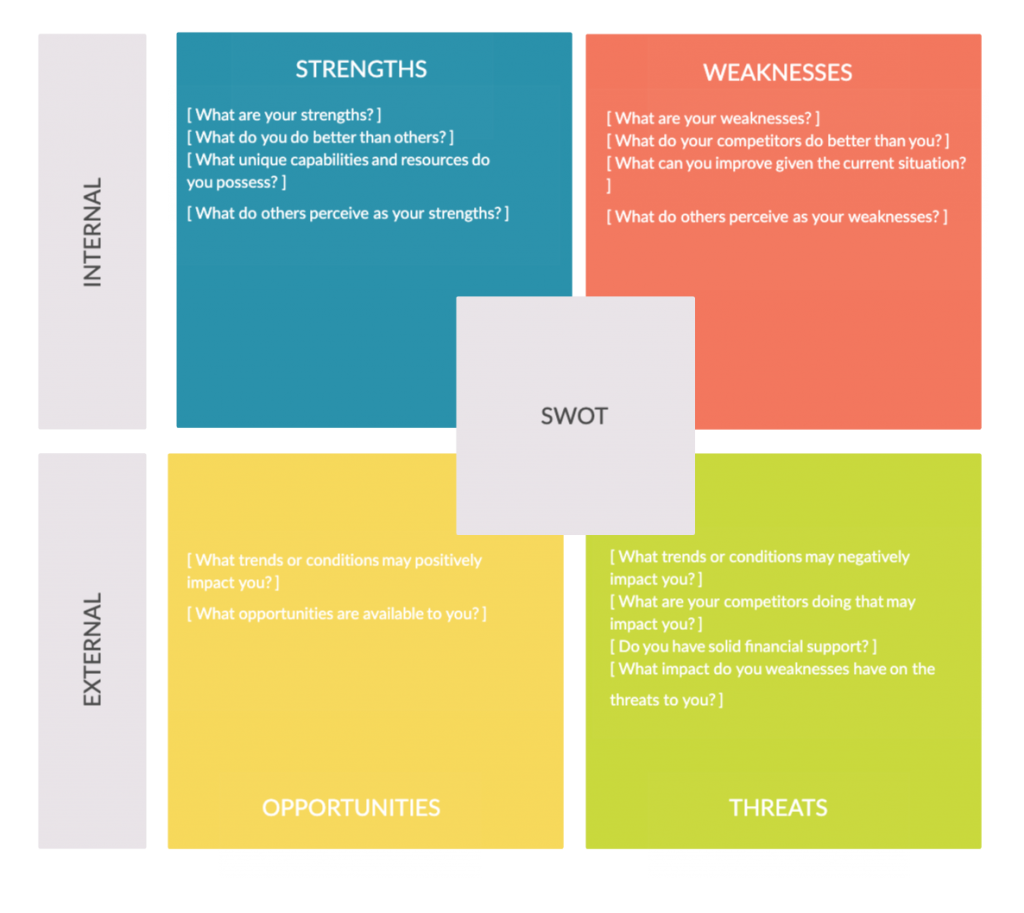
Organizational Chart
An organizational chart is a visual representation of the hierarchy/ structure of an organization. It also highlights reporting relationships between employees, their roles and responsibilities. In human resource planning, it can be used in a number of ways,
- To record information about current employee roles, responsibilities, skills, experiences, etc. You can also add additional information such as their educational qualifications, and demographical data. This will help you quickly identify the right personnel for the job.
- To create a roadmap of the staffing needs. You can mark labor deficiencies and surplusses on your company organizational chart as well.
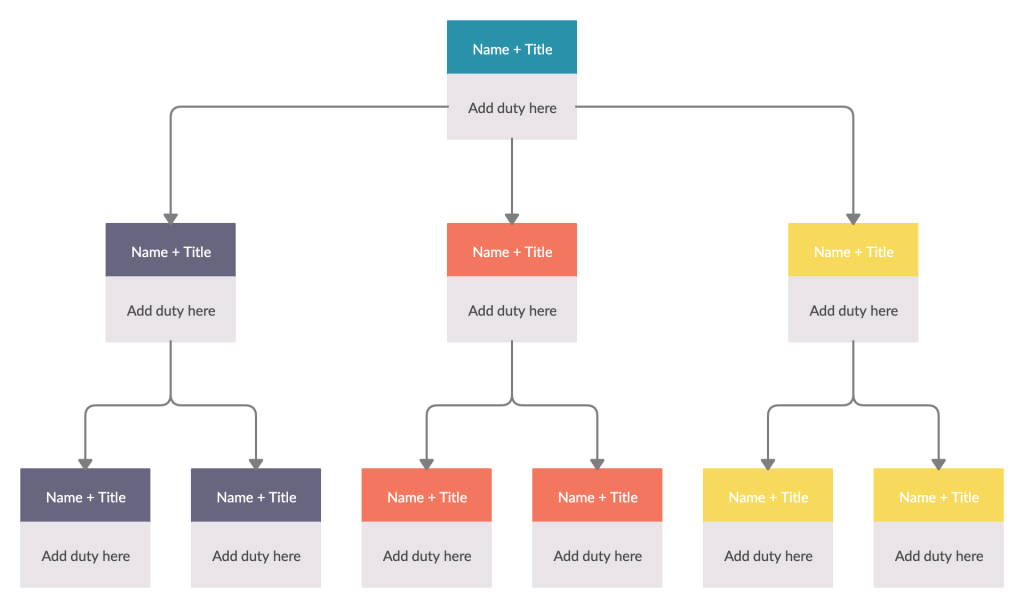
RACI Matrix
This is a chart, project managers use to assign roles and responsibilities to tasks in a project. It highlights who should be responsible, accountable, consulted and informed during a project.

9 Box Grid
The 9 box grid, also known as the performance-potential matrix, is widely used in employee development and succession planning. It helps evaluate your existing employees against their current performance and their future potential performance.
Rating your employees with the help of the 9 box grid helps you identify strong employees and those who are falling behind.
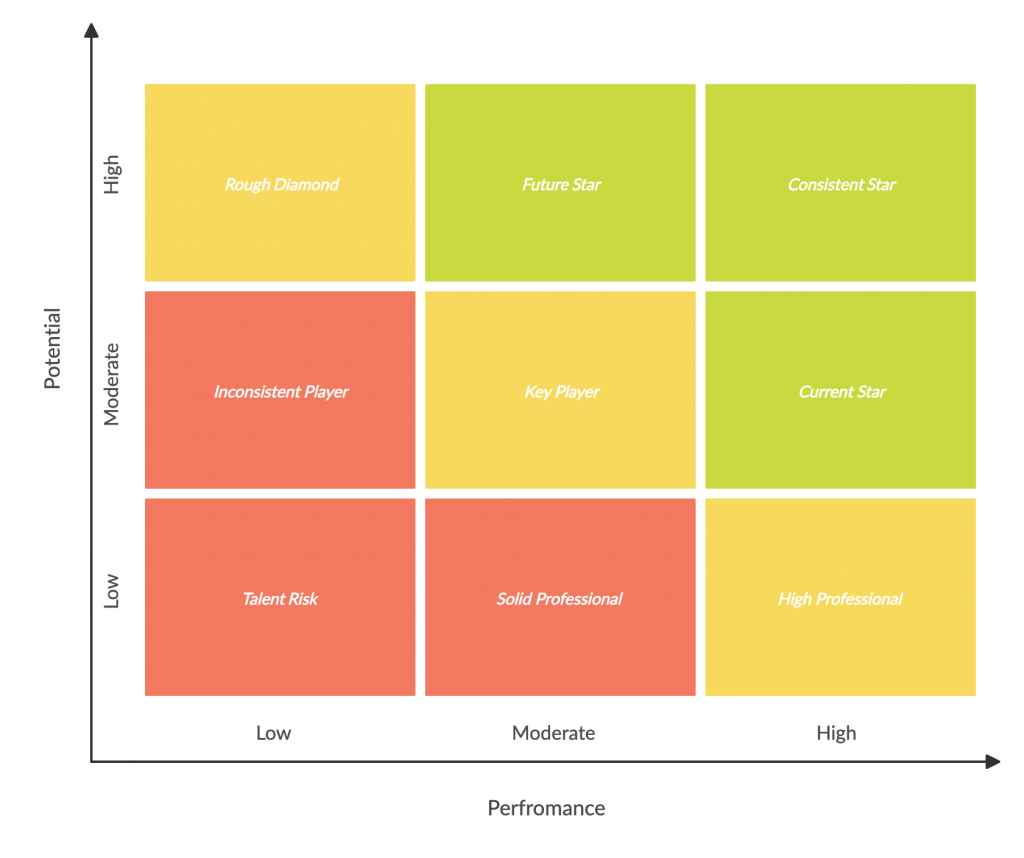
Scenario Planning
There are many scenarios, like technological advancements, natural disasters, political or economic changes that could drastically alter the future direction of your company. Ordinarily, you may not see them coming or plan for them.
By incorporating scenario planning in your strategic planning process, you can identify these different future scenarios, discuss how they will affect your organization and take precautionary measures.
You can incorporate scenario planning with human resource planning by examining scenarios that involve your changing future labor requirements.
Refer to our resource on scenario planning to learn about this tool in more detail.

Replacement Chart
This is a diagram that is similar to the organizational chart . It is used to identify potential candidates who can replace an employee who is retiring, transferring, etc. Individual replacement charts can be developed for each significant position in a company along with potential replacements.

Any Tips for Improving Manpower Planning?
In this post, we’ve basically covered everything you need to know about human resource planning , especially if you are a newbie. And we believe the templates provided will help you kickstart your project.
Already an expert in workforce planning? Do share the tips on tools and processes you swear by in the comments section below.
Join over thousands of organizations that use Creately to brainstorm, plan, analyze, and execute their projects successfully.

More Related Articles

Leave a comment Cancel reply
Please enter an answer in digits: 8 − 6 =
Download our all-new eBook for tips on 50 powerful Business Diagrams for Strategic Planning.
We use essential cookies to make Venngage work. By clicking “Accept All Cookies”, you agree to the storing of cookies on your device to enhance site navigation, analyze site usage, and assist in our marketing efforts.
Manage Cookies
Cookies and similar technologies collect certain information about how you’re using our website. Some of them are essential, and without them you wouldn’t be able to use Venngage. But others are optional, and you get to choose whether we use them or not.
Strictly Necessary Cookies
These cookies are always on, as they’re essential for making Venngage work, and making it safe. Without these cookies, services you’ve asked for can’t be provided.
Show cookie providers
- Google Login
Functionality Cookies
These cookies help us provide enhanced functionality and personalisation, and remember your settings. They may be set by us or by third party providers.
Performance Cookies
These cookies help us analyze how many people are using Venngage, where they come from and how they're using it. If you opt out of these cookies, we can’t get feedback to make Venngage better for you and all our users.
- Google Analytics
Targeting Cookies
These cookies are set by our advertising partners to track your activity and show you relevant Venngage ads on other sites as you browse the internet.
- Google Tag Manager
- Infographics
- Daily Infographics
- Graphic Design
- Graphs and Charts
- Data Visualization
- Human Resources
- Beginner Guides
Blog Human Resources
6 Steps to Create a Strategic HR Plan [With Templates]
By Jessie Strongitharm , Aug 25, 2022

The backbone of any successful business is the people and processes behind it — that’s why creating a human resources (HR) plan is key. This strategic document drives your business forward by evaluating where your workforce is at, and comparing it to future needs.
Without an HR plan, organizations can suffer from issues that would have otherwise been avoided. From productivity pitfalls to costly employee turnover, there’s no shortage of risks you can sidestep if you do human resource planning in advance.
Not sure where to start? No worries. I’ve outlined six steps you can take to create an effective HR plan that ensures your organization is well-staffed and well-served. You’ll also find a variety of HR templates that you can customize in just a few clicks — no design expertise required.
Click to jump ahead:
What is human resource planning?
- Assess employees’ current skill levels
- Forecast your labor needs based on available information
- Revisit your organizational design
- Outline how you will manage, motivate and retain talent
- Align your workforce planning with your budget
- Establish KPIs for your human resource planning objectives
Human resource planning is the process of considering the current and future “people needs” of an organization.
This involves evaluating an organization’s workforce structure and protocols to ensure operational goals are met, productivity stays high and future demands for labor and talent can be fulfilled.
The result of this process is the creation of an HR plan, which typically takes the form of a written document sometimes autogenerated using HR software . These documents tend to follow a similar structure to most strategic business plans and are created on an annual basis, by HR managers or company leaders.
Check out the template below for an example.
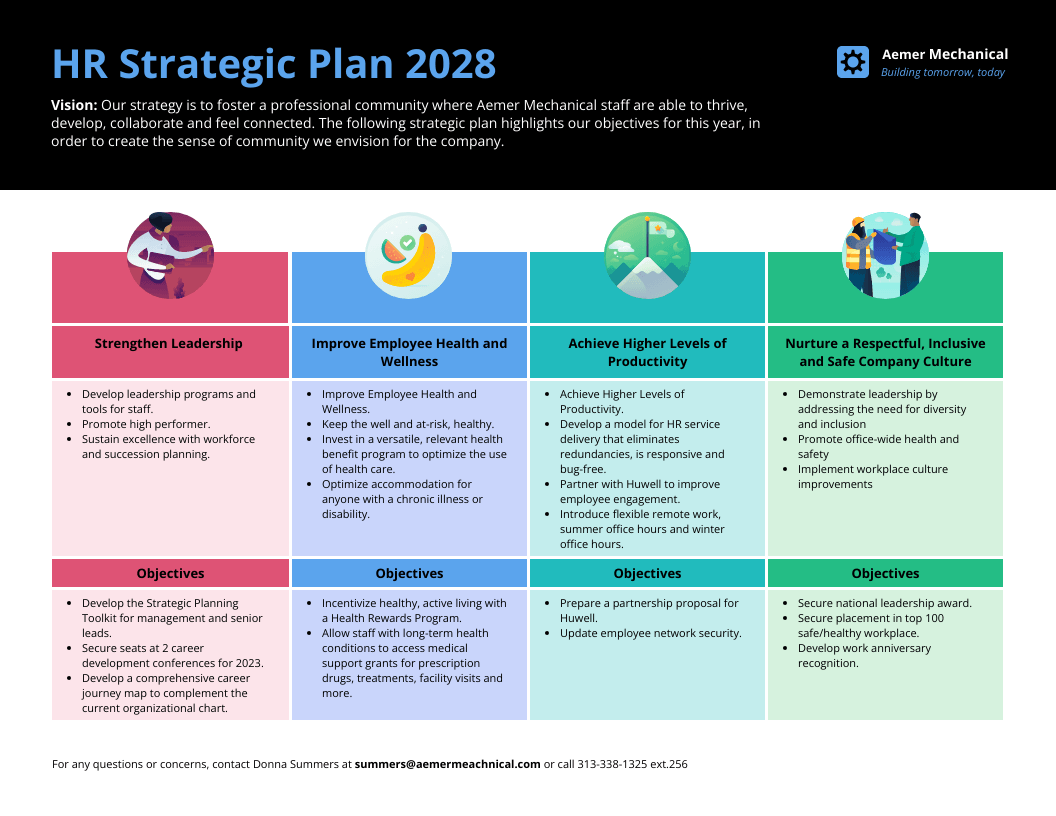
This eye-catching, one-page HR Strategic Plan Template offers a concise summary of your human resource planning efforts, so you can easily share info with colleagues.
Just swap out the text and visual assets for those of your choosing in Venngage’s editor , and you’re off to the races.
6 steps to create a strategic HR plan
Ready to create a strategic plan for the human resources that power your business? Here are six steps to help you succeed at the human resource planning process.
1. Assess current employees’ skill levels
The first step to creating a future-forward HR plan is to assess employees’ current skill sets, and compare them to your operational needs moving forward. This will help you identify gaps and inform any hiring of new employees.
Employees’ skill levels can be assessed by reviewing their work history, hard and soft skills and professional growth over time.
Using a matrix is a great way to understand where the skill gaps in your current workforce exist. Below is an example that describes the skills needed for different marketing roles.
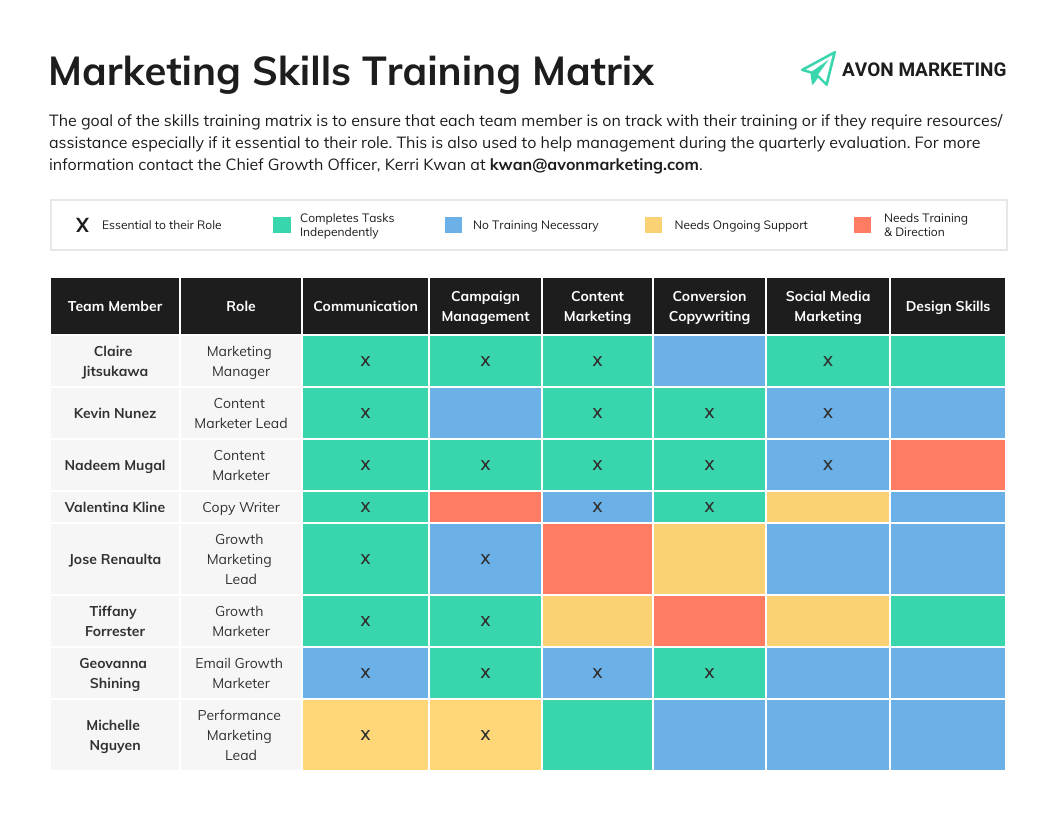
Don’t need it for marketing specifically? No worries — you can fully customize this template by swapping in your own text to examine any human resource gaps.
Another way to assess skills is by giving employees a questionnaire they can fill out. This Employee Competency Assessment Template does just that.

Based on the information collected, you’ll get a sense of what positions best suit each individual, and whether any upskilling or hiring is required.
2. Forecast your labor needs based on available information
Next in your strategic strategic HR management plan, you’ll want to consider the future. This involves accounting for any upcoming changes to your workforce, so operations can continue without error.
When forecasting labor needs, the following should be considered:
- Planned promotions
- Upcoming retirements
- Layoffs
- Personnel transfers
- Extended leaves of absence (i.e. maternity/paternity leave)
Beyond those, it’s a good idea to assess the impact of external conditions on your labor needs during your human resource planning. For example, new technological developments may decrease the amount of employees you require to operate your business.
3. Revisit your organizational design
Organizational design is the process of structuring the way a business operates so it can best achieve its goals. This is hugely important when it comes to your human resource planning process!
With a clear understanding of your organization’s strategic objectives in mind, reviewing your organizational design allows you to understand the staffing requirements you’ll need to succeed at them. This means taking into account your organizational structure and chains of command, as well as how work gets done and the way information flows.
From there, you’ll be able to see which departments need more team members so it can accomplish the organization’s objectives.
An easy way to get started is by using an organizational flow chart.

With its color coding and layout, even a new manager can quickly look at this chart to identify the people responsible for leading teams and making decisions.
And if there are any changes, it’s easy to to reflect them in the chart itself. All you need to do is customize the text and visual assets in Venngage’s Chart Maker as desired.
Not quite your style? There’s plenty of other organizational chart templates to choose from.

Here’s an organizational chart that’s perfect for small businesses that have limited employees. One quick look, and you’re good to go.
The bottom line is, no matter how big or small your business may be, you should always revisit your organizational design to optimize your workforce management and business operations.
Related: Types of Organizational Structure [+ Visualization Tips]
4. Outline how you will manage, motivate and retain talent
In this day and age, it’s a known fact that companies must provide more than just a paycheque to attract and retain talent, and encourage growth.
It’s true — studies have shown employees are more engaged in their work when they feel it is meaningful, fulfilling and slightly challenging. So your human resource plan should consider how to inspire such feelings, and what actions you can take to motivate employees to stay. (Hint: a strong HR training and development program is key.)
The talent management infographic template below is a great way to begin.

Using this process chart , you can detail the steps you’ll take to retain the talent you have. Reference it as needed in your human resource planning.
Another great way to keep staff motivated and geared towards their professional growth is by coming up with ideas for employee development . Facilitating a company culture that champions continuous learning guarantees your team will feel supported and challenged in all the right ways.
The two employee development plan templates below will help you do just that.

Though both templates are geared towards healthcare organizations, it’s easy to customize their content in Venngage to promote the continuous learning and development of employees in any industry.
As a result, your employees will be able to reach their full potential, while simultaneously supporting the long-term goals of your organization.
Related: 6 Employee Development Ideas for Efficient Training
5. Align your workforce planning with your budget
Let’s face it, human resources ain’t cheap.
Meaning, if you struggle at organizing and monitoring your HR budget, you’re bound to overspend on your initiatives —and no financially savvy business wants that.
That’s why I recommend including financial information in your HR planning process, so you can reference your budget and expenses as needed. This ensures you’ll be able to stay within range as you work towards achieving your strategic goals for human capital .
Plus, you don’t need to use one that contains walls of text and wack-loads numbers. Check out the clean and cheery option below — it’s as easy to fill out as it is to understand.

And if you’re looking to compare a forecasted budget to previous annual spending when strategizing your HR budget, the Budget Comparison Infographic Template below will help.

The bar graph is a great data visualization of annual expenses, organized by category. Just add (or import) any values to Venngage’s editor, swap out the text, and you’re ready to compare with ease.
Related: 10+ Expense Report Templates You Can Edit Easily
6. Establish KPIs for your human resource planning objectives
Measurable results are important when it comes to your HR planning processes, because they indicate whether your strategy is working or not.
Keeping those metrics in mind, your company can make adjustments and improve upon any future plans — AKA strategize for future success in business. That’s why your human resource plan should include info re: the specific key performance indicators (KPI) you’ll be measuring.
KPIs are established to help determine if HR strategies and plans are working. Much like those used for evaluating the performance of marketing or sales plan , KPIs for human resources are measurable results that indicate an organization’s success at achieving predetermined goals.
These may take the form of headcounts, turnover rates, demographic information, time to hire and employee satisfaction scores.
Here’s one employee satisfaction survey you can use to understand your workforce better.

When you’re ready to organize those HR KPIs in a document, the recruiting template below is perfect for keeping tabs at a glance.

Related: 10+ Customizable HR Report Templates & Examples
How do I make an HR plan?
After you’ve collected the data you need, you’ll want to convey this info in an engaging, professional manner for easy referencing and sharing amongst colleagues. Given this, using Venngage is the best route to go.
Here are the simple steps to help you bring an actionable HR plan to life:
- Outline the information you would like to include in your strategic hr plan
- Pick the human resource planning templates that best suits your needs
- Customize the templates’ text and visual assets so they speak to your organization
- Apply your company’s brand guidelines with a few clicks using Venngage’s automated branding feature, My Brand Kit
- Download and share as desired
Note: sharing is available free-of-charge. However, the option to download your creations and access features like My Brand Kit and Team Collaboration are available with a Business plan .
FAQ about HR plans
How long should an hr plan be .
There are no hard and fast rules when it comes to the length of an HR plan. That being said, if you’re going to share it with colleagues, you probably don’t want to create a 20+ page document. One to five pages should suffice.
Try to be as concise as possible when relaying the facts, and use data visualizations wherever possible to save room.
Do I need an HR contingency plan?
In the same way creating an HR plan is a proactive move that helps your organization account for future needs, it’s a good idea to devise an HR contingency plan. This ensures there’s a back-up plan in place should your initiatives not go as expected.
For example, if you’ve identified that you need five new hires to keep up with consumer demand, but the talent pool is lacking, a contingency plan could house suggestions for restructuring your workforce to mitigate this.
In other words, it’s best-practice to hope for the best, but prepare for the worst.
Is an HR plan different from an employee development plan?
Yes. While an HR plan is a strategic document describing how an organization addresses its personnel-related needs at a high-level, an employee development plan outlines the processes needed to help an individual achieve their professional goals.
Even though the human resource planning process may involve outlining some employee development tactics, it is not unique to each employee as in the case of an employee development plan.
Make your HR planning processes effortless
You don’t need a crystal ball to feel confident about your people moving forward. With a solid HR plan and strategy in place, you’ll prime your workforce — and all business endeavors — to succeed in even the most competitive of markets.
Just remember this: human resources planning, and creating strategic business plans in general, doesn’t have to be exhausting.
With Venngage’s huge selection of professionally-designed templates and easy-to-use editor, all it takes is a few minutes to produce a polished document perfect for all your needs. Sign up for free today !
- CRM Asignment Help
- MBA Assignment Help
- Statistics Assignment Help
- Market Analysis Assignment Help
- Business Development Assignment Help
- 4p of Marketing Assignment Help
- Pricing Strategy Assignment Help
- CIPD Assignment Help
- SWOT Analysis Assignment Help
- Operations Management Assignment Help
- Corporate Strategy Assignment Help
- Change Management Assignment Help
- Supply Chain Management Assignment Help
- Human Resource Assignment Help
- Management Assignment Help
- Marketing Assignment Help
- Strategy Assignment Help
- Operation Assignment Help
- Marketing Research Assignment Help
- Strategic Marketing Assignment Help
- Project Management Assignment Help
- Strategic Management Assignment Help
- Marketing Management Assignment Help
- Business Assignment Help
- Business Ethics Assignment Help
- Consumer Behavior Assignment Help
- Conflict Management Assignment Help
- Business Statistics Assignment Help
- Managerial Economics Assignment Help
- Project Risk Management Assignment Help
- Nursing Assignment Help
- Clinical Reasoning Cycle
- Nursing Resume Writing
- Medical Assignment Help
- Financial Accounting Assignment Help
- Financial Services Assignment Help
- Finance Planning Assignment Help
- Finance Assignment Help
- Forex Assignment Help
- Behavioral Finance Assignment Help
- Personal Finance Assignment Help
- Capital Budgeting Assignment Help
- Corporate Finance Planning Assignment Help
- Financial Statement Analysis Assignment Help
- Accounting Assignment Help
- Solve My Accounting Paper
- Taxation Assignment Help
- Cost Accounting Assignment Help
- Managerial Accounting Assignment Help
- Business Accounting Assignment Help
- Activity-Based Accounting Assignment Help
- Economics Assignment Help
- Microeconomics Assignment Help
- Econometrics Assignment Help
- IT Management Assignment Help
- Robotics Assignment Help
- Business Intelligence Assignment Help
- Information Technology Assignment Help
- Database Assignment Help
- Data Mining Assignment Help
- Data Structure Assignment Help
- Computer Network Assignment Help
- Operating System Assignment Help
- Data Flow Diagram Assignment Help
- UML Diagram Assignment Help
- Solidworks Assignment Help
- Cookery Assignment Help
- R Studio Assignment Help
- Computer Science Assignment Help
- Law Assignment Help
- Law Assignment Sample
- Criminology Assignment Help
- Taxation Law Assignment Help
- Constitutional Law Assignment Help
- Business Law Assignment Help
- Consumer Law Assignment Help
- Employment Law Assignment Help
- Commercial Law Assignment Help
- Criminal Law Assignment Help
- Environmental Law Assignment Help
- Contract Law Assignment Help
- Company Law Assignment Help
- Corp. Governance Law Assignment Help
- Science Assignment Help
- Physics Assignment Help
- Chemistry Assignment Help
- Sports Science Assignment Help
- Chemical Engineering Assignment Help
- Biology Assignment Help
- Bioinformatics Assignment Help
- Biochemistry Assignment Help
- Biotechnology Assignment Help
- Anthropology Assignment Help
- Paleontology Assignment Help
- Engineering Assignment Help
- Autocad Assignment Help
- Mechanical Assignment Help
- Fluid Mechanics Assignment Help
- Civil Engineering Assignment Help
- Electrical Engineering Assignment Help
- Humanities Assignment Help
- Sociology Assignment Help
- Philosophy Assignment Help
- English Assignment Help
- Geography Assignment Help
- History Assignment Help
- Agroecology Assignment Help
- Psychology Assignment Help
- Social Science Assignment Help
- Public Relations Assignment Help
- Political Science Assignment Help
- Mass Communication Assignment Help
- Auditing Assignment Help
- Dissertation Writing Help
- Sociology Dissertation Help
- Marketing Dissertation Help
- Biology Dissertation Help
- Nursing Dissertation Help
- MATLAB Dissertation Help
- Law Dissertation Help
- Geography Dissertation Help
- English Dissertation Help
- Architecture Dissertation Help
- Doctoral Dissertation Help
- Dissertation Statistics Help
- Academic Dissertation Help
- Cheap Dissertation Help
- Dissertation Help Online
- Dissertation Proofreading Services
- Do My Dissertation
- Business Report Writing
- Programming Assignment Help
- Java Programming Assignment Help
- C Programming Assignment Help
- PHP Assignment Help
- Python Assignment Help
- Perl Assignment Help
- SAS Assignment Help
- Web Designing Assignment Help
- Android App Assignment Help
- JavaScript Assignment Help
- Linux Assignment Help
- Coding Assignment Help
- Mathematics Assignment Help
- Geometry Assignment Help
- Arithmetic Assignment Help
- Trigonometry Assignment Help
- Calculus Assignment Help
- Arts Architecture Assignment Help
- Arts Assignment Help
- Case Study Assignment Help
- History Case Study
- Case Study Writing Services
- Write My Case Study For Me
- Business Law Case Study
- Civil Law Case Study Help
- Marketing Case Study Help
- Nursing Case Study Help
- ZARA Case Study
- Amazon Case Study
- Apple Case Study
- Coursework Assignment Help
- Finance Coursework Help
- Coursework Writing Services
- Marketing Coursework Help
- Maths Coursework Help
- Chemistry Coursework Help
- English Coursework Help
- Do My Coursework
- Custom Coursework Writing Service
- Thesis Writing Help
- Thesis Help Online
- Write my thesis for me
- CDR Writing Services
- CDR Engineers Australia
- CDR Report Writers
- Homework help
- Algebra Homework Help
- Psychology Homework Help
- Statistics Homework Help
- English Homework Help
- CPM homework help
- Do My Homework For Me
- Online Exam Help
- Pay Someone to Do My Homework
- Do My Math Homework
- Macroeconomics Homework Help
- Research Paper Help
- Edit my paper
- Research Paper Writing Service
- Write My Paper For Me
- Buy Term Papers Online
- Buy College Papers
- Paper Writing Services
- Research Proposal Help
- Proofread My Paper
- Report Writing Help
- Story Writing Help
- Grant Writing Help
- CHCDIV001 Assessment Answers
- BSBWOR203 Assessment Answers
- CHC33015 Assessment Answers
- CHCCCS015 Assessment Answers
- CHCECE018 Assessment Answers
- CHCLEG001 Assessment Answers
- CHCPRP001 Assessment Answers
- CHCPRT001 Assessment Answers
- HLTAAP001 Assessment Answers
- HLTINF001 Assessment Answers
- HLTWHS001 Assessment Answers
- SITXCOM005 Assessment Answers
- SITXFSA001 Assessment Answers
- BSBMED301 Assessment Answers
- BSBWOR502 Assessment Answers
- CHCAGE001 Assessment Answers
- CHCCCS011 Assessment Answers
- CHCCOM003 Assessment Answers
- CHCCOM005 Assessment Answers
- CHCDIV002 Assessment Answers
- CHCECE001 Assessment Answers
- CHCECE017 Assessment Answers
- CHCECE023 Assessment Answers
- CHCPRP003 Assessment Answers
- HLTWHS003 Assessment Answers
- SITXWHS001 Assessment Answers
- BSBCMM401 Assessment Answers
- BSBDIV501 Assessment Answers
- BSBSUS401 Assessment Answers
- BSBWOR501 Assessment Answers
- CHCAGE005 Assessment Answers
- CHCDIS002 Assessment Answers
- CHCECE002 Assessment Answers
- CHCECE007 Assessment Answers
- CHCECE025 Assessment Answers
- CHCECE026 Assessment Answers
- CHCLEG003 Assessment Answers
- HLTAID003 Assessment Answers
- SITXHRM002 Assessment Answers
- Elevator Speech
- Maid Of Honor Speech
- Problem Solutions Speech
- Award Presentation Speech
- Tropicana Speech Topics
- Write My Assignment
- Personal Statement Writing
- Narrative Writing help
- Academic Writing Service
- Resume Writing Services
- Assignment Writing Tips
- Writing Assignment for University
- Custom Assignment Writing Service
- Assignment Provider
- Assignment Assistance
- Solve My Assignment
- Pay For Assignment Help
- Assignment Help Online
- HND Assignment Help
- SPSS Assignment Help
- Buy Assignments Online
- Assignment Paper Help
- Assignment Cover Page
- Urgent Assignment Help
- Perdisco Assignment Help
- Make My Assignment
- College Assignment Help
- Get Assignment Help
- Cheap Assignment Help
- Assignment Help Tutors
- TAFE Assignment Help
- Study Help Online
- Do My Assignment
- Do Assignment For Me
- My Assignment Help
- All Assignment Help
- Academic Assignment Help
- Student Assignment Help
- University Assignment Help
- Instant Assignment Help
- Powerpoint Presentation Service
- Last Minute Assignment Help
- World No 1 Assignment Help Company
- Mentorship Assignment Help
- Legit Essay
- Essay Writing Services
- Essay Outline Help
- Descriptive Essay Help
- History Essay Help
- Research Essay Help
- English Essay Writing
- Literature Essay Help
- Essay Writer for Australia
- Online Custom Essay Help
- Essay Writing Help
- Custom Essay Help
- Essay Help Online
- Writing Essay Papers
- Essay Homework Help
- Professional Essay Writer
- Illustration Essay Help
- Scholarship Essay Help
- Need Help Writing Essay
- Plagiarism Free Essays
- Write My Essay
- Response Essay Writing Help
- Essay Editing Service
- Essay Typer
- APA Reference Generator
- Harvard Reference Generator
- Vancouver Reference Generator
- Oscola Referencing Generator
- Deakin Referencing Generator
- Griffith Referencing Tool
- Turabian Citation Generator
- UTS Referencing Generator
- Swinburne Referencing Tool
- AGLC Referencing Generator
- AMA Referencing Generator
- MLA Referencing Generator
- CSE Citation Generator
- ASA Referencing
- Oxford Referencing Generator
- LaTrobe Referencing Tool
- ACS Citation Generator
- APSA Citation Generator
- Central Queensland University
- Holmes Institute
- Monash University
- Torrens University
- Victoria University
- Federation University
- Griffith University
- Deakin University
- Murdoch University
- The University of Sydney
- The London College
- Ulster University
- University of derby
- University of West London
- Bath Spa University
- University of Warwick
- Newcastle University
- Anglia Ruskin University
- University of Northampton
- The University of Manchester
- University of Michigan
- University of Chicago
- University of Pennsylvania
- Cornell University
- Georgia Institute of Technology
- National University
- University of Florida
- University of Minnesota
- Help University
- INTI International University
- Universiti Sains Malaysia
- Universiti Teknologi Malaysia
- University of Malaya
- ERC Institute
- Nanyang Technological University
- Singapore Institute of Management
- Singapore Institute of Technology
- United Kingdom
- Jobs near Deakin University
- Jobs Near CQUniversity
- Jobs Near La Trobe University
- Jobs Near Monash University
- Jobs Near Torrens University
- Jobs Near Cornell University
- Jobs Near National University
- Jobs Near University of Chicago
- Jobs Near University of Florida
- Jobs Near University of Michigan
- Jobs Near Bath Spa University
- Jobs Near Coventry University
- Jobs Near Newcastle University
- Jobs Near University of Bolton
- Jobs Near university of derby
- Search Assignments
- Connect Seniors
- Essay Rewriter
- Knowledge Series
- Conclusion Generator
- GPA Calculator
- Factoring Calculator
- Plagiarism Checker
- Word Page Counter
- Paraphrasing Tool
- Living Calculator
- Quadratic Equation
- Algebra Calculator
- Integral Calculator
- Chemical Balancer
- Equation Solver
- Fraction Calculator
- Slope Calculator
- Fisher Equation
- Summary Generator
- Essay Topic Generator
- Alphabetizer
- Case Converter
- Antiderivative Calculator
- Kinematics Calculator
- Truth Table Generator
- Financial Calculator
- Reflection calculator
- Projectile Motion Calculator
- Paper Checker
- Inverse Function Calculator

Human Resource Management Functions
Assessment Purpose: The primary purpose of this assessment is to enhance students’ research, analysis and referencing skills.
The secondary purpose is to give students the opportunity to demonstrate their critical thinking and written communication skills.
The third purpose is to demonstrate that you have commenced appropriate research for Assessment 3.
Before starting this assessment, please read the assessment rubric at the end of this document. You should always check the unit website for specific instructions, which may be updated continuously.
Assessment Task: You are required to compile an Annotated bibliography of 5 peer-reviewed journal articles.
Step 1. Select an industry sector. Read the Assessment 3 Essay task and identify which sector you will study for Assessments 2 and 3 (e.g. agriculture; construction; financial services; health care; hospitality; manufacturing; mining; retail; transport).
Step 2. Undertake research of the recent academic literature since 2010. Identify five (5) academic peer reviewed journal articles relevant to the Assessment 3 Essay topic. It is suggested that you align your selected articles with the unit themes from Weeks 3 to 5 (e.g. job design, HR planning, recruitment and selection). It is recommended that you undertake your research via the online ‘search’ of CQUniversity Library. You cannot use articles from your Assessment 1 presentation for Assessment 2.
Step 3. Write 2 paragraphs on each article (400 words) For each journal article, you are to write approximately 400 words in two paragraphs. The first paragraph will summarise the main ideas of the article, identifying the hypothesis, purpose, research methodology and conclusions. The second paragraph will identify how you will use that article in relation to the Assessment 3 Essay.
Step 4. Use an appropriate format Present your Annotated bibliography in a format similar to that provided below. For more information, see the library guide for writing an annotated bibliography.
Topic: Human Resource Management Functions
Annotated Bibliography Introduction: Human Resource Management Functions are broader terms that impactmanagement and performance of any organisation. The HR manager needs to take timely-based and effective recruitment decisions that can help in the achievement of goals. Most of the jurisdictions in organisations that long time in identifying new HR strategies. Change is the necessary aspect of management. The HR manager needs to pool the best resource out of the hundred applicants. This is focused on identification of the Human Resource Management Assignment tools and implementation of new strategies from time to time. To reduce the long-term negative impacts, recruitment, selection training, planning and job-design are important aspects that impact the staffing decisions.
Article 1: Fevre, R. (2012). Social Mobility, Equity and the Politics of Recruitment. Sociology Compass, 6(9), 740-750. Retrieved from: http://unpan1.un.org/intradoc/groups/public/documents/UN/UNPAN021814.pdf
Keywords: Recruitment, Human Resource Management
The purpose of this journal article is to explain how the retention of high-quality professionals is crucial to the success of the organization. The market is extremely competitive. Today, manpower is available with diverse skills. The recruiters need to be more selective. This article is written for the public service audience. The article talks about different recruitment and human resource management strategies. Human Resource Management Assignment manager need to be more careful in the recruitment process. The retention of skilled talent is necessary for the Organization. The HR managers need to develop management strategies impact the staff morale. The highlights of this journal article are external and internal recruitment strategies, on the job training and value-added services to customers (Fevre, 2012). The Human Resource Management Functions and recruitment process can be conducted internally through referrals or promotion or transfer of personnel. The HR managers can advertise the jobs posting through the electronic boards or company newsletters and office memoranda. A commonly observed practice is referrals are word-of-mouth publicity and a lower cost recruiting methodology. The Organization can organize job fairs, and best of the companies can participate. The dozens of candidates are available, all at one place. The recruitment strategy is focused at bringing the job seekers and job givers at one place.
The drawback of this journal article is public service Organizations are more worried about the market share. These organizations operate in a monopolistic environment. The HR managers need to emphasize on the formulation of new strategies that aim at targeting the best experts. The Public-sector organizations need to comprehend the demands and wants of the consumers. Public sector organizations are open to scrutiny. The journal implies attracting the pool of talent for the different opportunities that are available in the market. There must be greater honesty and transparency in HR recruitment practices. A great plethora of opportunities are available in the market. The Human Resource Management Assignment needs to discuss the strategic and tactical role of Human resource implications in the longer run. Although, a commonly observed practice is there are few publicly operating organizations that maintain fairness in the recruitment processes? These organizations are aimed at protecting the individuals from harmful practices. The public service organizations need to maintain the detailed procedures and practices, if necessary to eliminate the discrimination. Cost is one the essential word-of-mouth factor that defines the retention policy of an organization. Another factor is convenience- as it allows the screening of candidates in a shorter span of time.
Article 2: Hoch, J., & Dulebohn, J. (2013). Shared leadership in enterprise resource planning and human resource management system implementation. Human Resource Management Review, 23(1), 114-125. Retrieved from: https://www.ikbooks.com/home/samplechapter?filename=168_Sample-Chapter.pdf
Keywords: Human Resource Planning, Strategic Planning
Human resource planning and strategic planning are the key areas of any Organization. This article refers to adequate source and effective application of human resources. This article is for those organizations who are undertaking an extensive research study. The human resource management functions must be taken to fulfill the mission, vision, and objectives of the Organization. The prime function of any HR in an organization is to hire the right people at the right time. An intermittent re-assessment of all the new developments in the Organization must be reviewed (Hoch &Dulebohn, 2013). The Human resource planning function should aim at effective planning and motivational processes. The Organizations should be able to estimate the number of resources required to run an Organization. Human resource planning is also referred to as- “Manpower planning”. The chief function of human resource department is to carry out the recruitment function at different levels. This can be for different purposes. HR plan operates at a national level, sectoral level, industry level, unit level and departmental level. The main aim of Human Resource Management Assignment is to ensure the demand and supply of manpower at different levels. This can be for serving the educational purposes, industrial developmental purposes or any employment plans made in the organization.
The drawback of this article is the development of concurrent employment plans in any company. The organizations are unable to forecast the need of manpower at different levels. The proportionate distribution of human resources at every level should be decided depending upon significance. The HR planning department must take into account the operational levels of every different department. A specific company is in question when human resource needs are not met with time. A business plan of any company is functional when the objectives defined can evade the unexpected disturbance in the production levels. This specifies lack of talented manpower in the Organization; therefore, appropriate strategies should be adopted. The Human Resource Management Functions should be all-inclusive and cover, marketing plans, financial plans and operational plans of an organization. The HR capabilities must be integrated and unified in an Organization. The organization must be able to fulfil the input needs and serve the desired output to customers. There are environmental constraints in every organization; therefore, a strategic plan must be formulated. The Human resource planning function aims all the employees in an organization to communicate the needs and wants, and constraints felt at different levels. An integration of all the Human resource plans is required at all the levels.
Article 3: Roberts, G. (2002). Employee Performance Appraisal System Participation: A Technique That Works. Public Personnel Management, 31(3), 333-342. Retrieved from: https://pdfs.semanticscholar.org/93cc/62d7f8a9188c88c509df80b6550f98bc5e7f.pdf
Keywords: Performance Appraisal, Performance Management
This article refers to employee engagement and commitment levels that are made by an employee to an organization. An organization wants a member those feel highly- encouraged and finish the given task on time. This article is for all the low-level and mid-level Organizations who want to study the long-term appraising techniques. The employees should give inner soul to the company’s success. The performance appraisal and performance management are two techniques those are aimed at developing a strong link between the current objectives of employees with the present objective of the Organization. It is similar to mapping your own vision and mission plan with your company’s plan. There must be a co-existence of mutual trust between the employer and employee (Roberts, 2002). The performance appraisal technique measures employee absenteeism from work, the greater engagement with patrons, fewer mistakes and earning higher profits within stipulated period of time. The competitiveness factor among employees can be developed by the utility of the employee engagement technique. The primary objective of a Human Resource Management Functions technique is enhancing the growth and development of individual and Organizations. Performance Management and performance appraisal are two terms which could be used as synonymous to each other. Performance rating methods can be used for foreseeing the performance levels of an employee in an organization.
The critical point in the article is how to review the performance of an employee in an Organization on a concurrent basis. Performance management refers to the successful attainment of objectives in an organization. Performance appraisal function implementation is critical to the success of every organization. The Performance management function is one main component of performance appraisal. To maximize the output and efficiency of groups and employees, the human resource functions must be in place. The performance of various teams existing inorganization is a critical process. The operational performance appraisal system assesses new incomings and plans for the growth and development of employees. In an Organization, where the performance appraisal system has been implemented, more than 60 percent of employees have shown dissatisfaction and did not like receiving. In such a scenario, this process can be thought for complete elimination. The most important aspect is to provide the feedback to the managers and initiate employee participation process. The employees and employers must be able to make the valid decisions. In today’s global competitive world, enhanced output and productivity can be served only when performance appraisal technique is in implementing stage. Managers must take into account all the legal considerations and an effective appraising system must be studied.
Article 4: Lozano, R. (2011). Creativity and Organizational Learning as Means to Foster Sustainability. Sustainable Development, 22(3), 205-216. Retrieved from: https://www.cebma.org/wp-content/uploads/Guide-to-the-after_action_review.pdf
Keywords: Action After Review, Organizational Learning
Organizational learning and development assess the need for intermittent identification of performances and taking lessons from success and failures, from time to time. This article refers to -The Action after Review (AAR) is a human resource management technique that is, conducted at the end of the project or event or a program. This Human Resource Management Assignment article focuses on the domestic and international level companies who are undertaking programs or events and a purposeful study for those who want to review the performance levels. The HR management function of any Organization devises strategies and team learning takes place through objective and mission statement. Action after Review follows a structured approach and identifies the strengths, weaknesses, opportunities, and threats in a given area of work (Lozano, 2011). Some of the famous companies using Action after Review programs are GE, Motorola, and others. The implementation of Action after Review is a necessary aspect of an Organization as it answers these questions- What are the occurrences in future? What has happened? Whether an employee participation is up to the mark or not? Can the things be improvised in an Organization? The Action after review plan is focused to withstand the resources in an Organization. The management committee needs to propose recommendations.
The critical point in this article is-how to effectively manage one-time projects to long-term events. The management needs to measure the event outcomes, there is always scope for growth and development and good learning prospects. It should be made mandatory for employees to attend the Action after review program. Another critical point is-when Action after review program should be used by the Organizations-just after an event or when a program ends. What functional structure should be adopted by the company practices to provide the maximum advantage to the Organizations? The implementation of Action after review plan is not possible without a moderator. How to define whether informal or spontaneous Action after review plan must be implemented before the event ends or after an event? The formal AAR can be implemented through the help of a facilitator and spontaneous AAR can be directed through team manager. Another critical point in Action after review technique is time barrier. For instance- Informal AAR can be conducted without allotting any time-span. This can be as short as ten minutes and success barriers cannot be measured. A formal AAR can be done within a stipulated time period of one to two hours. Few strategies must be recommended for the successful implementation of informal AAR.
Article 5: Strych, J. (2015). Job Rotation and Employer Learning About Human Capital. SSRN Electronic Journal. Retrieved from:http://ergo-plus.com/wp-content/uploads/Job-Rotation.pdf
Keywords: Job Rotation, Quality Standards
This article reviews the structured exchange of employees between two different departments, within an organization at different time intervals is known as Job Rotation. Enhancement of more work and increase of physical demands, therefore, adds a change in the complete structure of employment. This article is for public sector and private sector an Organization who wants to understand the overall requirements of different rotational jobs. The HR function of any Organization should focus on the development of reliable and methodical job rotations. The advantages of job rotation are focused to share the risk factors present in an organizational environment. The Human Resource Management Assignment function needs to identify the high-risky jobs and address and troubleshoot, whenever possible. When job rotation is implemented within an Organization, it helps in reducing the physical demands associated with a job (Strych, 2015). The job rotation is focused to increase work efficiency and enhance quality standards in different processes. The Job rotation capabilities aim at the elimination of ergonomic problems. The employers must be able to identify the problems as early as possible. Consult management and group leader’s work together to decide on which internal departments are suitable for the job rotation program. Strategically driven job rotation programs give best competitive advantage.
The critical point in this article is the implementation of job rotation program at different units, within a company. The management undergoes through numerous barriers. The crucial aspect is that every department or job is not appropriate for the job rotation program. Some of the problems encountered are- issues with the product quality, employee productivity losses, employees hesitate to rotate because of the difficulties associated with jobs. Restriction of ability is one main reason that inhibits the job rotation process. In industrial organizations, various threats imposed by the union workers, especially for the job compensation rules. The employees are not convinced about the compensation cost that is received. The Human resource management functions find very difficult to implement the job rotation programs. A research study undertaken suggests-employee productivity and product quality suffer with the enactment of job rotation. The company’s culture must be enduring for the successful implementation of frequent job rotation programs. The strategists should draw an effective job design that is, based on job factors- applications utilized, training and development requirements, external and internal forces, frequent opportunities and threats. The productivity gains can become lower without a real-based job rotation program. The employers have greater flexibility levels when adequate training is given to employees on Human Resource Management Functions.
References Fevre, R. (2012). Social Mobility, Equity and the Politics of Recruitment. Sociology Compass, 6(9), 740-750.
Hoch, J., & Dulebohn, J. (2013). Shared leadership in enterprise resource planning and human resource management system implementation. Human Resource Management Review, 23(1), 114-125.
Lozano, R. (2011). Creativity and Organizational Learning as Means to Foster Sustainability. Sustainable Development, 22(3), 205-216.
Roberts, G. (2002). Employee Performance Appraisal System Participation: A Technique That Works. Public Personnel Management, 31(3), 333-342.
Strych, J. (2015). Job Rotation and Employer Learning About Human Capital. SSRN Electronic Journal.
CHECK THE PRICE FOR YOUR PROJECT
Number of pages/words you require, choose your assignment deadline, related samples.
- Overcoming Challenges: Stakeholder Participation in Oman's Renewable Energy Transition
- HRM Considerations for Establishing La Gustocoffee in China: Challenges and Strategies
- (BM562 CW1) HR management and recruitment strategies assignment on designing effective HR policies and guidelines
- HRM ethics assignment on strategies business managers can adopt to ensure fair treatment of their staff
- (SHR011-3) CPD portfolio assignment reflective upon the updated CIPD profession map against the present skills and behaviours
- Human resource management assignment explaining the importance and contribution of human resource
- Human resource assignment focussing on communication marketing of Vaseline
- Human resource management assignment evaluating the influence of organisational culture and organisational changeon British Petroleum
- Human resource management assignment explaining the significance of HR and its duties
- Human resource is involved in recruitment of potential candidates in the organisation, training them to retain them for a definite period of time
- (BMP6026) International HRM assignment on application of International HRM Practices in HSBC Holdings Plc
- (BUSM2022) HRM training assignment on strategies businesses can use to improve staff training programs
- (HRMT11011)Human resource management assignment identifying the HRM issues in Australian workforce
- (HX3W 04)Strategic leadership assignment on the strategic human resources management and its changing landscape in organizations
- Strategic Human Resource Management assignment on Sainsbury's Plc HPM policies
- (BMG935 CRN 13712) Hrm assignment on IHRM policies and practices in the multinational context
- (WELF2010)lifespan development assignment critically analysing Baptist care services Australia
- Employee Retention Assignment Analyzing How Organizations Can Maximize Employee performance
- Employee Satisfaction assignment Plan for Costa Hemel Hempstead
- Human Resource Management assignment focusing on the HR practices of Commonwealth Bank Australia
- (HRMT20024) Human Resource Management Essay: Key Challenges in Attracting and Retaining Workforce in the Education Sector
- (HRMT20024) HRM Essay: Key Challenges in Attracting and Retaining Workforce in Australian Health Sector
- Human Resource Management Assignment: Cause of Poor Performance Management at the Cavendish Hall Hotel
- (ENG5100) Blue Oceans Consulting: Advantages and disadvantages of remote teams during COVID-19
- (HRMT20024) SHRM Essay: Challenges In Attraction And Retention Of Staffs In Healthcare Industry

Looking for Your Assignment?

FREE PARAPHRASING TOOL

FREE PLAGIARISM CHECKER

FREE ESSAY TYPER TOOL
Other assignment services.
- SCM Assignment Help
- HRM Assignment Help
- Dissertation Assignment Help
- Marketing Analysis Assignment Help
- Corporate Finance Assignment Help

FREE WORD COUNT AND PAGE CALCULATOR

QUESTION BANK
ESCALATION EMAIL
To get answer.
Please Fill the following Details
Thank you !
We have sent you an email with the required document.

+61 481607654

Human Resource Planning
Task 1: reason and stages involved in hrp with relevance to organisation.
For commencing any business activity, the most important element is manpower. Without human resource, company cannot operate with corporate functions. In modern time, maximum work is carried out through machines but to work upon artificial intelligence also, human resource is required. It is the biggest asset for any organization as without proper manpower skills, firm cannot run business (Ulrich, 2013). They are essential at every level ranging from top level management authorities to lower level workers. In every business entity, human requirement is analyzed and certain functions are performed before appointing people. It is done after having appropriate planning of human demand.
We Can help!
We can help you in completing your assignment on time. Learn more about our exquisite services and see how we can help!
With context to the relevant firm which is TESCO, they require a huge manpower resource as it is a retail firm. Since they involve immense number of departments that begins from operational to service chain, the requirement for human resource also originates at a very large scope (Armstrong and Taylor, 2014). The main reason for human need in stated firm is service sector. It is one of the largest retail chain in UK. Thus, it has to serve a huge crowd of people on a daily basis which is not possible without efficient manpower. Hence, company has to perform recruitment on a regular scheduled basis as and when they launch any new service scheme. Another reason is to manage the operational function by the company. They are commencing business at a very large scale, hence they need to commence human resource planning at a very huge level. This is done so that the work could be managed accordingly with efficiency in results.
Since it is the largest retail market, the planning for manpower need also has to be done accordingly. It goes in a proper systematical and hierarchical manner (Gatewood, Feild and Barrick, 2010). The stages involved in human resource planning process in TESCO goes as follows:
- First of all, new plans which needs to be executed are evolved and processed further.
- The initial planners are the foremost people and they generate the new demands to carry out their advance operations (Monk and Wagner, 2012).
- As and when the procedure is carried further, demand also grows which leads to commencement of HRP in organization.
- Finally, to enlarge the scope of activity, people with similar designations are recruited and their selection ends up the HRP function.
TASK 2: COMPARING EFFECTIVENESS IN SELECTION PROCESS OF TWO SIMILAR COMPANIES
Every company possess different recruitment process according to the working profile in which they deal. Some companies operate at a very large scale thus require dependable and reliable workforce that is selected after a particular process. Whereas in some emerging companies, they simply require workers to carry out their operations irrelevant of their qualifications and profile to which they belong (Anderson, 2009). It is often seen that developing companies hire those people whom they exploit and make the most out of them. This sometime proves to be the negative perception which may go against firm's policy. While the developed organization appoint workers according to their profile and are dedicated towards one single duty. This enhance the quality of work that is carried out.
Comparing such occurrences, the best results can be obtained from two distinct unit working under same industries. Tesco and Aldi can be taken as medium to differ as both the companies are grocery retail chain market. Tesco is the leading firm while Aldi is into the race of capturing market. Their process of selection along with effectiveness can be elaborated very efficiently.
Tesco follows the systematic method of recruiting peoples (Lengnick-Hall and et.al., 2009). They commence the test to judge the qualities of person. It even organizes case study programs and competition as the medium of hiring masses. Once the candidate passed out from the relevant competition, it goes to the second stage.
Effectiveness – This is very effective as it renders quality mass to the company. Company gets good quality of human resources which serves the company throughout the business period and provide desired results with efficiency.
On the other hand, since Aldi is a developing company, they hire people irrelevant of their profile. It often targets those people who are in search of jobs and are ready to works even at low remunerations.
Effectiveness – It is effective just as it provides workforce at cheap cost. The selection process thus at Tesco is quite good and competitive while Aldi hire people for the sake of increasing labor workforce to carry out operations of business at a large scale (Khan, 2010).
TASK 3: ASSESING LINK BETWEEN MOTIVATIONAL THEORY AND REWARD
Motivation is the process of boosting the morale of an individual or a team to perform a particular activity with more energy in order to come out with enhanced results. This method often proves useful as a person feels superior by getting-noticed among his overall staff. On the other hand reward is also a method of motivation only but it includes certain cost to the company. Under this method, the person is not only praised for his deeds but is also paid for his cause towards attainment of objective (Assess the link between motivational theory and reward, 2014).
There are numerous theories proposed for such objectives which are directly related with the appraisal to staff. Out of them, Maslow's need hierarchy theory and Herzberg's theory are most comprehensive. Maslow's theory suggested five levels of human needs which employees desire to fulfill in their entire lifetime of service. They are more influencing towards rewards rather than motivation theories (Dezdar and Sulaiman, 2009). It prescribed that reward is the best way too motivate employees. Under his approach the levels mentioned are:
Assignment Prime is an online assignment writing service provider which caters the academic need of students.
Physiological needs – It includes basic human needs which are food, water and other amenities.
Safety requirement – Job security, resources optimization and health are covered under the following factor.
Personal needs – Intimacy with family and affection are place in this category.
Esteem needs – This involves achievements, respect and designation under corporate environment.
Self actualization – It is the top most need that comprises highest authority, creativity and problem solving responsibilities (Chen and Huang, 2009).
Herzberg on the other side signifies only two factors which are moral environment support and motivational factors. No cost of service is applied under this approach. Manager who are in support of this theory often neglects monetary factors and emphasizes more towards morale enhancement through designating authorities and promotional techniques (Chen and Huang, 2009).
Tesco is the best example of linking these theories because they include both the approaches under their portfolio. For highly designated employees, they adopt Herzberg theory sa they are financially satisfied. For lower level worker, they follow Maslow's approach where they provide them basic amenities to survive and get satisfaction (Collings and Mellahi, 2009).
TASK 4: PROCESS OF JOB EVALUATION AND DETERMINING PAY
Job evaluation is a method of determining the worth of a job in context of the results they are obtaining. In the following topic, determination of pay scale is also treated as part of job evaluation where after evaluating the status, salaries are allocated to individual at the described company (Kallunki, Laitinen and Silvola, 2011). The process of evaluating work goes as follows:
Job analysis – It is a method by which the information required from each department is taken and is analyzed with the desired objectives. This is done on the basis of few criteria which includes:
Job description – The profile for job is prepared comprising of roles, responsibilities and duties to be performed by the respective candidate.
Job specifications – It is concerned with the necessary skills and qualifications required by the person to get selected for the particular designation (Tabassi and Bakar, 2009).
Job rating – Under the following technique, job are ranked according to their worth. The method for evaluating each job remains constant to get the best and fair results. At Tesco, this is done through ranking, point rating method and many more.
Job classification – It is the last step to evaluate job. Under this technique, jobs are classified according to their profile and ranks. With respective classification, employees are hired according to their qualifications. This creates a systematic chain of designations at concerned organization (Bloom and Reenen, 2011).
Pay scale determination – According to the different jobs availed by person in company, his pay scale is determined. This is done to make difference in jobs at various levels which is practiced at Tesco.
TASK 5: EFFECTIVENESS OF REWARD SYSTEM
Monetary incentives always prove to be useful in every organization as people tend to work for the sake of money only. It is observed that financial reasons are more taken into consideration as compared to other non monetary factors (Dimov, 2010). Its value can easily be justified with support of the following reasons:
Employees are more dedicated towards financial matters. They are ready to work and give the best efforts for the sake of money. They are oriented to achieve monetarism. In order to earn money, they can work over their potential which is beneficial from the company's perspective.
Workers feel more superior than before as other than financially appreciation, he also feel praised among other peers. For the sake of more incentive, they tries to put more effort which in turns proves beneficial for the respective company (Bozionelos, 2009).
Other staff members also gets into race of gaining monetary rewards. This leads to enhanced working environment in corporate world. By providing financial rewards to any employee working at Tesco, they get an opportunity to obtain results which carries more value as compared to the amount of incentive paid to them (Bozionelos, 2009).
TASK 6: METHODS TO MONITOR EMPLOYEES PERFORMANCE
Appraisals are given after judging the performance of employees. On the basis of their efficiency levels, they are given rewards both in monetary as well as non financial terms. In every company, employees are examined on certain parameters and then only they are justified to be reward holder (16 ways to measure employee performance, 2015). Some of the factor which are considered while analyzing performance includes:

Service criteria – The amount of service they have provided and number of clients handled by each individual is one method of judging employees performance which is practiced at Tesco.
Quality feedback – The satisfaction level perused by clients with service of each worker is noticed under feedback service. It is also one of the process adopted by concerned company. It is one of the biggest factor that helps Tesco while providing rewards (Molenaar, Park and Washington, 2009).
Creative innovations – At retail sectors, there are immense opportunities for developing and implementing new ideas. Workers are welcomed with different approaches in techniques to enhance sale figures. Observing their progress, their ideas becomes the trend for which concerning employees are highly appraised.
Regular tardiness – At Tesco, punctuality is very much measured. Since it is a retail sector, it require regularity of people to provide their services. Those who are regular in their work with complete attendance over duty, they tend to be the reward holder which boost them to become more punctual in the future course of performance (Cummings and Worley, 2014).
Management by objectives – Targets are given to each individual to get completed over a given period of time. When they successfully attain the objective with efficiency in results, they are classified under reward taking category. It is the main theory proposed under given organization to enhance working (Cummings and Worley, 2014).
Adhere to policy – It is one of the biggest factor while judging out the employees to monitor work performance. Companies like Tesco are very strict towards their rules and regulations (Bozionelos, 2009). Employees who follows the regulations made by the company on a regular basis are more shifted towards the positive aspect and are motorize to promotional activities.
Self grooming - It is often observed that some employees have their perception to groom themselves with point of time. Such people deserve great heights as they tries to contribute with their best efforts. It proves to be beneficial from the context of both, employees as well as the organization. These kind of people are transmitted to higher level of authorities in a quick mean of time (Dimov, 2010). This is because they possess skills to upgrade the level of company which is highly appreciable by Tesco.
TASK 7: REASONS FOR CESSATION OF EMPLOYMENT
Employees are referred as the back bone of company where he works for the welfare of the firm. But every company at one phase of its working tenure has to undergo procedure to terminate employees in order to make sustainability in the organization. There are several reasons for the company to cease the worker (The reasons for job termination, 2015.).
Some of the factors may involves:
Economic inefficiency – Although multinational companies works at a very large scale but they also gets affected by the economic crisis. During deep depression in the external market, there might be a possibility by the company to suspend its workforce in order to sustain its financial position. Under such conditions, employees have to suffer a lot due to their negligence by the organization.
Non punctuality – If it is found that any employee is very frequent in taking leaves and fall short of attendance at his workplace, then it also may leads to termination from job. It is highly practiced at Tesco as it is a retail sector and requires workforce every time (Gallicano, 2009).
Non performance – When any individual fails to generate the desired results while performing any activity, it may cause cessation in his employment from the relevant company. Even by vesting sufficient time and resources, if it fails to produce results then he may be terminated from job. This leads to failure in planning process of the concern person which in turn leads to loss for the company too.
Misbehavior – It is the most unethical deed that is not tolerated at every reputed company. Similar it happens at Tesco also. People who are not good in their attitude and are ill mannered, then they are not accepted in the company's associated workforce. They are rejected at a glance that lead to their cease in employment (Gallicano, 2009).
TASK 8: EMPLOYMENT EXIT PROCEDURE
In large scale operating firms, management can not terminate any employee all of a sudden. They have to follow a legal procedure and carry out the process in a systematic manner. In case of any default from the company's side, they can also be punished legally by the consent of terminated employee (Jensen, Sandström and Helin, 2009). Discussing the process of termination at Tesco and comparing it with Aldi, they are quite similar in nature but are not identical. The method goes as follows:
At the prior stage, employees are analyzed on the basis of few parameters. Those factors may includes behavior, at equates, attendance and most importantly his performance. If any person satisfies on all the platforms with efficiency then he is entitled for the reward but if he fails to stood thorough in them, then it may be a cause of concern to them. He may be rejected from his job. Hence a performance chart is made. It is practiced in both the organizations (Dezdar and Sulaiman, 2009).
After judging performance, if any worker has to be rejected then he is given a warning to improve. This is a chance availed by the concerning employee to make changes in the lacking activity. This is not done at Aldi but is induced at Tesco (Armstrong and Taylor, 2014).
In case of future arising of the similar obligation, he is given a prior notice for leaving the job. These are the final instructions which has to be followed by the employee. He can not argue over them. A notice is given to facilitate the worker for survival till the next job opportunity is prevailed by him. This is also performed at both the companies (Dezdar and Sulaiman, 2009).
Finally employee is terminated and all his dues are paid to make the company free from all his duties. This is done to avoid future claims by the candidate over reputed firm. Similar practice is performed at Aldi as well as Tesco as both are globally reputed organization (Armstrong and Taylor, 2014).

TASK 9: IMPACT OF LEGAL AND REGULATORY FRAMEWORK ON EMPLOYMENT CESSATION
While terminating any employee, certain legal frameworks need to be accessed in order to justify the constitutional act (Tabassi and Bakar, 2009). The major legal activities that are included under the employment cessation are as follows:
Subjective legal facts are taken into consideration. Those legal compliance consist of the following regulations where there should be:
- Presence of a bilateral agreement to terminate the employment relationship where there are mutual consent of both the parties involving the employer as well as employee.
- Creation of unilateral consideration in which either of the party takes initiative of termination. It may be the employer representing company or an employee on his own individual behalf.
- Instant termination can take place from any of the party. This might be done without any reason from any of the participant under process (Dimov, 2010).
Official or lawful virtues could take place where employee gets bounded to lave the organization without any prior warning. This may be:
- From company's perspective being in default, it may be due to recession or any other official reason where employee is not in fault but it is required by the company.
- In case of employee being founded under guilt, he may be terminated even by law if he is found suspicious in any criminal activity (Kallunki, Laitinen and Silvola, 2011).
Legal facts or non controllable activity may also contribute in the termination of employment. Briefing them as:
- Expiry of the time period in case of contractual appointment. After the completion of fix time, either the employment relation can be maintained through renew of policy or cessation of employment comes into act (Collings and Mellahi, 2009).
- May be by the death of employee which is uncontrollable in nature. It is non performing activity from both the parties but still employment comes to an end (Anderson, 2009).
- Ulrich, D., 2013. Human resource champions: The next agenda for adding value and delivering results. Harvard Business Press.
- Armstrong, M. and Taylor, S., 2014. Armstrong's handbook of human resource management practice. Kogan Page Publishers.
- Gatewood, R., Feild, H. and Barrick, M., 2010. Human resource selection. Cengage Learning.
- Monk, E. and Wagner, B., 2012. Concepts in enterprise resource planning. Cengage Learning.
- Anderson, V., 2009. Research methods in human resource management. Chartered Institute of Personnel and Development.
- Lengnick-Hall and et.al., 2009. Strategic human resource management: The evolution of the field. Human Resource Management Review.
- Bloom, N. and Reenen, J. V., 2011. Human resource management and productivity. Handbook of labor economics.
- Dimov, D., 2010. Nascent entrepreneurs and venture emergence: Opportunity confidence, human capital, and early planning. Journal of Management Studies.
- Jensen, T., Sandström, J. and Helin, S., 2009. Corporate codes of ethics and the bending of moral space. Organization.
- Cummings, T. and Worley, C., 2014. Organization development and change. Cengage Learning.
- Gallicano, T. D., 2009. Personal relationship strategies and outcomes in a membership organization. Journal of Communication Management.

Avail The Benefit Today!
To View this & another 50000+ Free Sample
Share Your Requirements Now for Customized Solutions.
Delivered on-time or your money back
For Best Human Resource Management Assignment Help

- Zero Plagiarism
- 24*7 Live Support
- Unlimited Revisions
- Free Plagiarism Report
- Money-Back Guarantee
- No Privacy Infringement
To Make Your Work Original
Check your work against paraphrasing & get a free Plagiarism report!
Check your work against plagiarism & get a free Plagiarism report!
Get citations & references in your document in the desired style!
Make your content free of errors in just a few clicks for free!
Generate plagiarism-free essays as per your topic’s requirement!
INTRODUCTION Human Resource Management is a function which includes activities related to hiring, maintaining and motivating organisational workforce. It is a primary function in every business organisation which helps them to fulfill their staffing needs (Armstrong and Taylor, 2014). In this
INTRODUCTION Human resource manager play an important role in an organisation where they supposed to manage human resource at workplace (Alpkan and et. al., 2010). Managing human capital and perform well leadership get done by the effective contribution of HR manager of a company so that they
INTRODUCTION There are certain factors which are necessary to run a company and for development of an organization by earning profits or providing services. Aim of this report is to analyse knowledge, attributes and skills needed in the HR department of an establishment. It is a base on
INTRODUCTION Human Resources Office will play an essential role in the success of the corporate objectives. HR’s commitment and responsibility to provide high quality operations of the Human Resources Office will assist in providing the company with Management excellence (Reilly and Williams
Introduction Human Resource Development is the integration of training and learning programs, career development efforts in order to enhance skills and knowledge of employees and effectiveness of an organisation. HR Department is held responsible to develop competencies of individuals through
Introduction There are many problems which are faced by society so there are some centres set up by government or voluntary associations to provide satisfaction to society. There is essential role of volunteers to achieve objective behind setting them (Armstrong and Taylor, 2014). There are
Introduction Human resource management is important for the organization in order to achieve objective combining and the organizational goal. In HRM it includes recruiter people, motivation of employee, performances appraisal etc. this all have beneficial effect on the organization. The present
Introduction Managing human resource in an organization is highly important in order to carry out the the management of financial and physical resources in a most effective manner. It is one of the managerial activities of an organization. Further, in a general manner human resource management is
Introduction Managing human resource is the process of managing the employees as assets of the business. It includes recruitment and hiring, training, motivation, performance appraisal and many others for the talent acquisition and retention as well. Health and social care organizations have to
Introduction HRM is strategic approach that is used in overall effective management of workers working in an organisation. HR department of any type of organisation is responsible for designing overall structure of organisation so that productivity of employee can be increased to certain level. In

Avail the Best Assignment Writing Services in Just One Tap!
Add "5% extra off on app"
We use cookies to ensure that we give you the best experience on our website. If you continue to use this site we will assume that you are happy with it. Know more

Please rotate your device
We don't support landscape mode yet. Please go back to portrait mode for the best experience
404 Not found

IMAGES
VIDEO
COMMENTS
Describe the steps in the development of an HRM plan. As addressed in Section 2.1 "Strategic Planning", the writing of an HRM strategic plan should be based on the strategic plans of the organization and of the department. Once the strategic plan is written, the HR professional can begin work on the HR plan. This is different from the ...
Module Alignment. Assignment: Becoming a Changemaker. Module 1: The Role of Human Resources and Module 2: Human Resources Strategy and Planning. Assignment: Develop a Diversity Allies Program. Module 3: People Analytics & Human Capital Trends and Module 4: Promoting a Diverse Workforce. Assignment: Job Description Research and Development.
HUMAN RESOURCE PLANNING ASSIGNMENT 1. Linking HR Strategies to a Differentiated Organizational Strategy. Human Resource Policies, provide a framework for organizations in which consistent decisions can be made and about how people are treated with all equity and fairness in an organization ( SpriggHR, 2020).In every organization, there are different HR Policies specific to ensuring that ...
Managing Your Human Assets Module 1: Human Resource Planning fModule 1 - p 2 2. DEVELOPING AN HR PLAN 2.1 Forecasting Hiring Needs The daily demands and hectic lifestyle of business owners and managers often has an unfortunate by-product: human resource planning gets placed on the bottom of the list of things to get done.
Human resource planning (HRP) is a part of human resource management (HRM), so discussion of HRP without any overview of HRM is incomplete. For defining HRP it is necessary to define about HRM. 3 Human Resource Management: Human resource management can define as a process of handling and managing people of an organization.
Human Resource Planning - HRP: Human resource planning, or HRP, is the ongoing, continuous process of systematic planning to achieve optimum use of an organization's most valuable asset — its ...
The key HR priorities this year. 1. Development and training. The biggest priority for HR Managers, according to Gartner, is building critical skills and competencies. This is how successful organizations maximize workplace performance and maintain competitive advantage. It's an area where digital can really drive HR.
Human resource planning (HRP) enables an organization to better realize its goals by ensuring that it makes efficient and effective use of its human capital. Today's workforce is characteristically ambitious and hence, volatile. Rosenberg (n.d.) reiterates that employees switch careers an approximated three times in their working life.
The human resource plan relies on identifying deficits or surplus in the company. You'll need to determine if you need to begin recruiting or training, transition, or develop voluntary retirement processes and redeployment in case of a surplus. Include priorities and critical planning issues in your plan.
The actual process of human resource planning involves five general phases. Listed below is a summary of each step to help you navigate the process: 1. Analyze organizational objectives and plans. Success in HR planning relies on its connection to business goals, so you must start with a final purpose in mind.
impact areas of human resources (HR) such as recruitment, training, employee. compensation, and performance evaluation (Schwind et al, 2019). The information can. also provide some insight on how well designed (or ill-designed) a job is. Poorly. designed jobs often lead to low productivity, high turnover, resignations, etc. (Schwind et. al, 2019).
Assignment Choice #2: Human Resource Plan . You are the HR Manager of the Fairview, Pennsylvania, store of a large home improvement products chain. You have been asked by the organization's board of directors (OD) to present the annual human resource plan for your store. Your PowerPoint presentation for the BOD should include the following: 1.
Action plan: finally, once the identification of surplus and shortage of human resources is done, HR Manager can implement adequate plans for resolving the problems. 2.3 One can describe recruitment as a process to find and hire the best and qualified applicants either from in-house or external resources for filing up a vacant job position in a ...
The following are some of the areas your human resource plan should cover: A detailed description of how your business will achieve the objectives outlined in your human resources strategy. This section of your human resources plan should come first. It needs to be a specific action plan that will list timelines for certain goals and objectives.
Step 1: Identify the current supply of human resources. The planning process starts by analyzing the current labor pool. Identify the strengths and weaknesses of your organization with regard to the number of employees, their skills, experiences, qualifications, positions, performance levels, age, benefits, salary levels, languages spoken ...
Here are six steps to help you succeed at the human resource planning process. 1. Assess current employees' skill levels. The first step to creating a future-forward HR plan is to assess employees' current skill sets, and compare them to your operational needs moving forward.
Presented by: Binod Ghimire. Concept. • Human resource planning is the process of. forecasting, development, and controlling human. resource in an organization. • According to Stone, "Human ...
HR Management Assignment Sample. This document provides an overview of strategic human resource management for two large retail organizations, Tesco and Walmart. It discusses the importance of SHRM and how it contributes to organizational objectives. The document also outlines how to develop an HR plan, including identifying business factors ...
7 Steps to creating an HR strategy. We've outlined 7 key steps based on Deloitte's HR Strategy Framework to help you design an HR strategy: . 1. Consider the market and trends: Analyze the external market and trends that are impacting your industry. 2. Understand the business strategy: Know the business strategy and be clear on the must-win battles for the business, the key value drivers ...
This is focused on identification of the Human Resource Management Assignment tools and implementation of new strategies from time to time. To reduce the long-term negative impacts, recruitment, selection training, planning and job-design are important aspects that impact the staffing decisions. Article 1: Fevre, R. (2012).
The stages involved in human resource planning process in TESCO goes as follows: First of all, new plans which needs to be executed are evolved and processed further. The initial planners are the foremost people and they generate the new demands to carry out their advance operations (Monk and Wagner, 2012).
oum bussiness school semester year 2018 bbpb 2103 human resources management matriculation no: 920510055012001 identity card no. :920510055012 telephone no ... Assignment 2023 - BDNP3103; Human Resources; ... related to gender balance by focusing on succession planning practices and developing long-term female talent in the succession pipeline ...
Human resource planning (HRP) is the continuous process of systematic planning into achieve optimum benefit of an organization's employees.